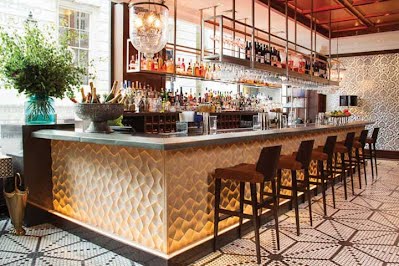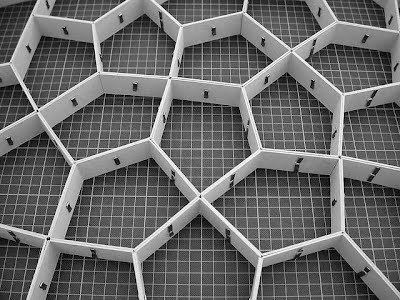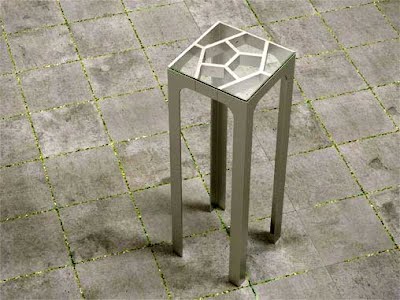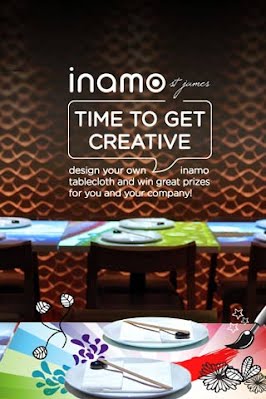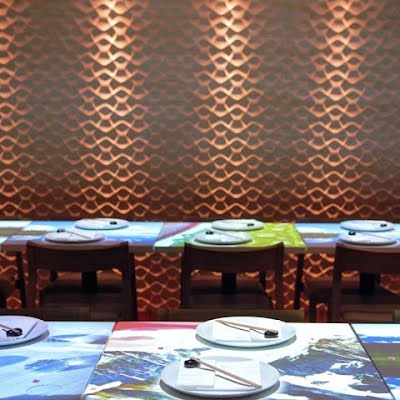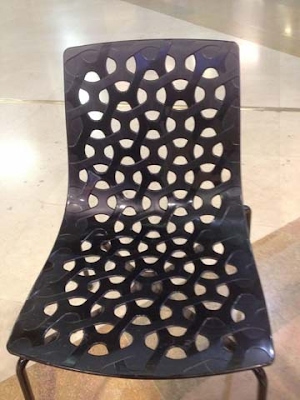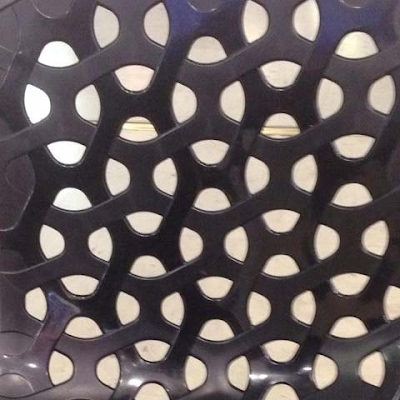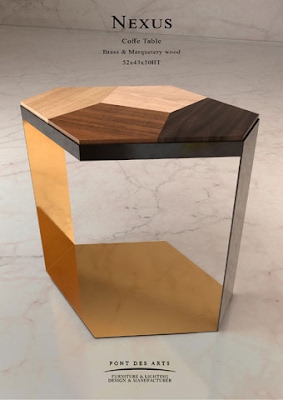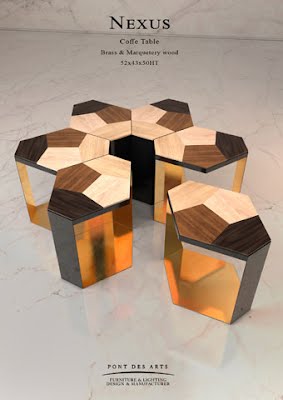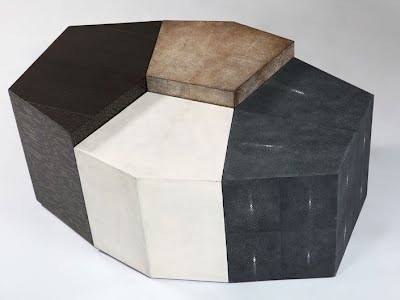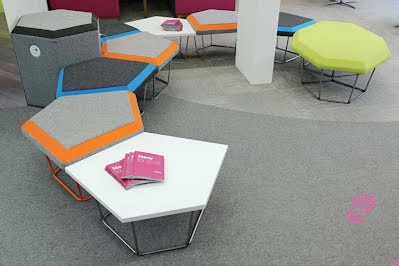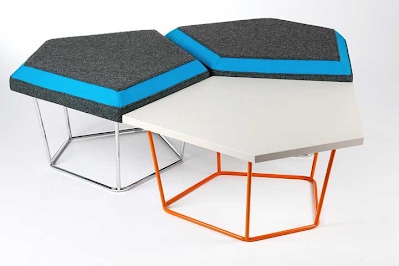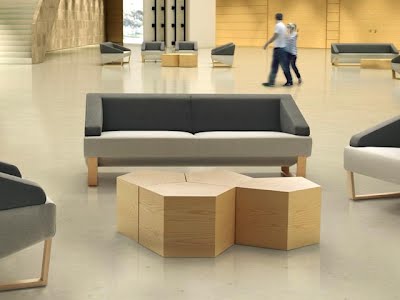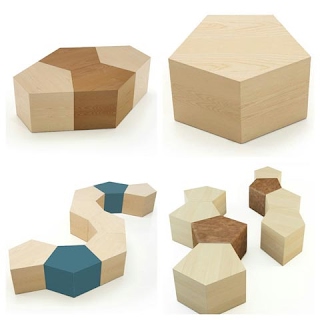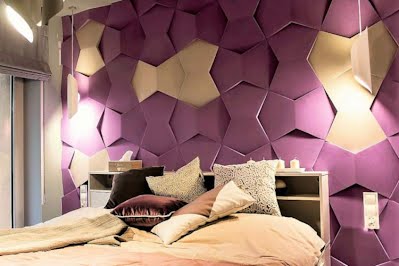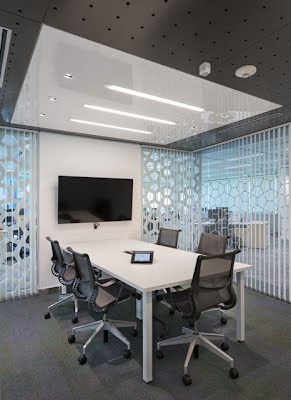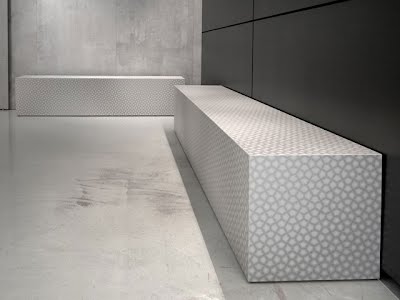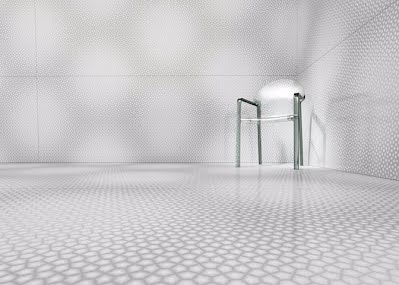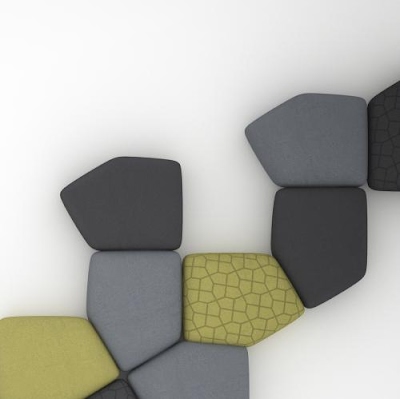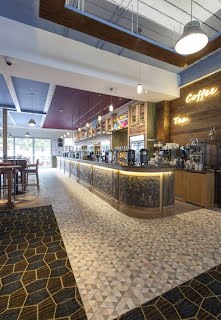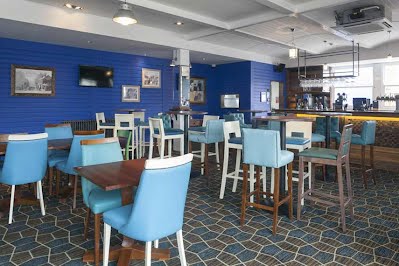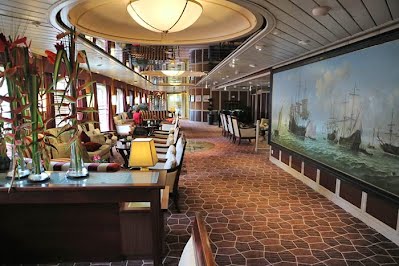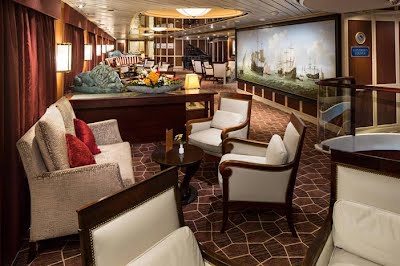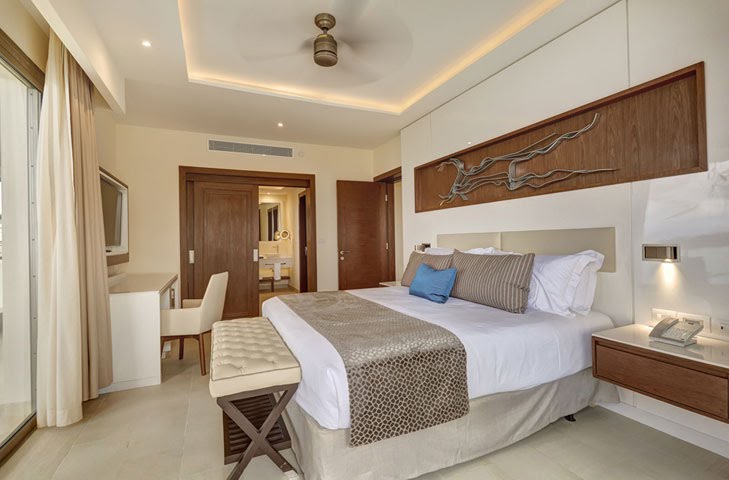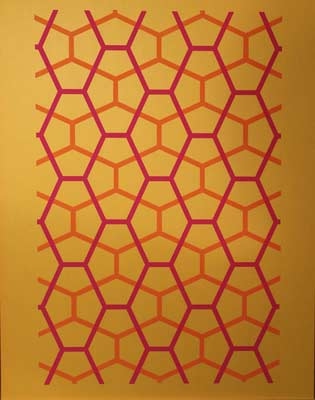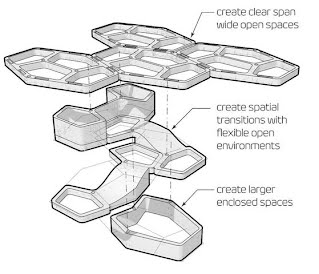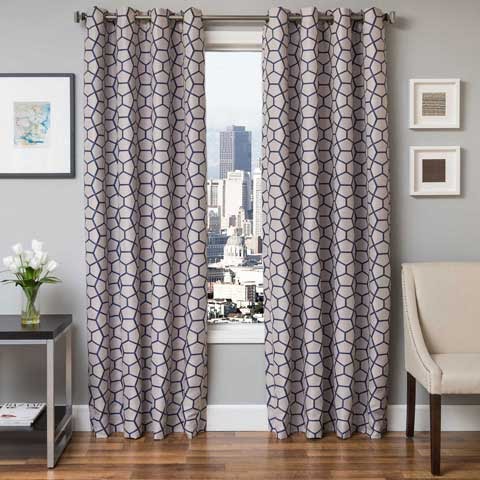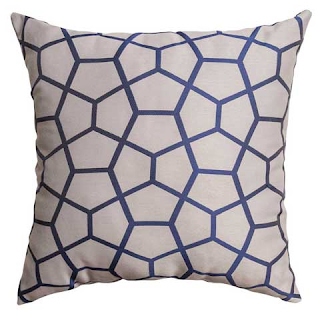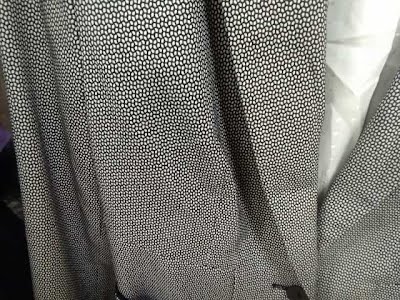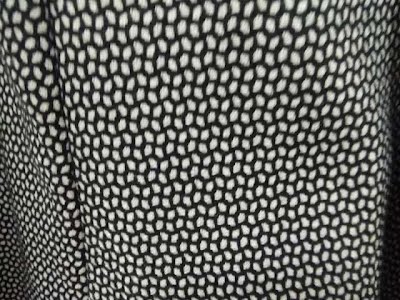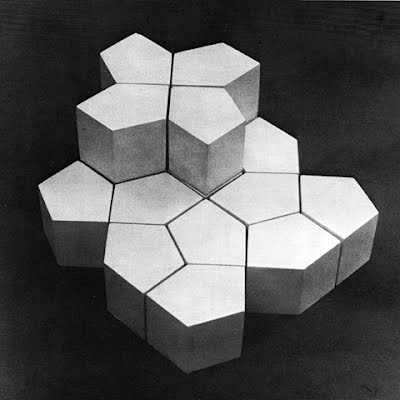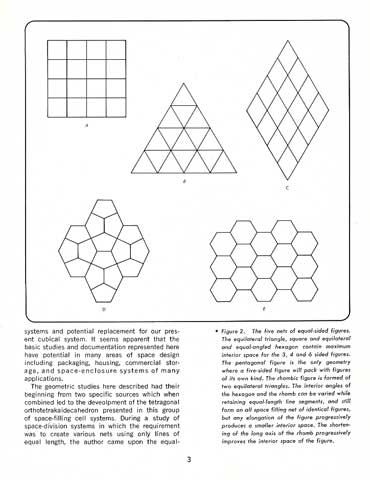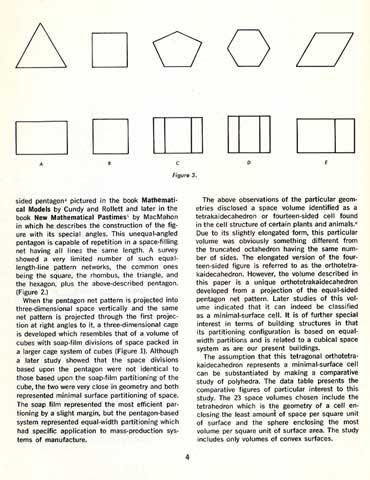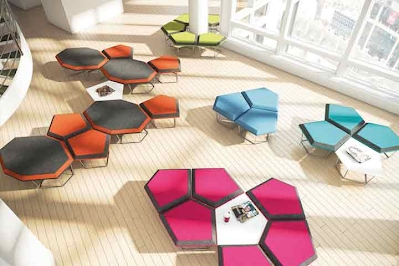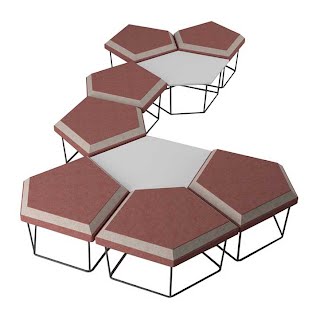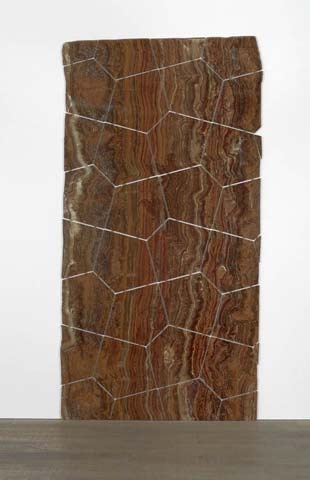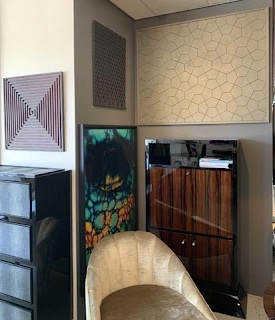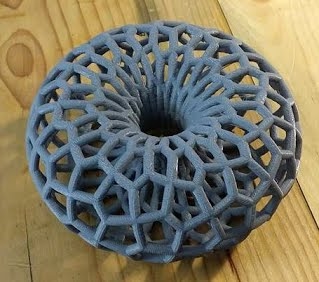Under Rearrangement 6 December 2019+ A continuation of the Cairo Tiling 'as' theme, with upon having distinct, dedicated sections for extensive architecture, flooring, paving and wall tiles applications, I now turn my attention, to what I term as miscellaneous entries. As the title implies, this is a non-dedicated section, of a wide range of such miscellaneous entries. As such, I differentiate these into two categories, 'major' and 'minor', as Miscellaneous 1 and Miscellaneous 2. Miscellaneous 1 consists of entries that have 3 or more from a single entry, whilst Miscellaneous 2 is of two or fewer. The criteria is somewhat arbitrary, with the cut-off point judged to result in roughly equal length pages. This is for the sake of a more digestible page. Previously, at least of the last incarnation, the entries of Miscellaneous 1 and Miscellaneous 2 were of a single long extensive page, which with ad hoc additions had become a little disjoint and unwieldy. This separation into distinct entities thus results in a more orderly arrangement and page. by the very nature this study is in a permanent state of flux, as I find time to research, add to the page and on occasion add sightings sent to me by correspondents.The entries are ordered as by the frequency of instances, with the more numerous first. A miscellaneous, largely ‘for fun’ collection of various non in situ Cairo tiling aspects, in which the Cairo tiling is to be seen in a variety of objects and applications. The format for each entry is initial outline, a picture and discussions, ending with links. On occasions, I am unable to show pictures as the image holder did not respond to request for permissions, and where this arises I thus instead give a link. I began by placing sightings individually, broadly as found, rather than as a type, such as all instances of tables and panels etc. However, as of the 2019 return, I now place as to type, and frequency, which at least gives a modicum of order. Note that the compilation is of an ad hoc nature, of instances as found upon my researches, and therefore the collection, being in a permanent state of flux (and so on occasion inconsistent, especially as regards numbering), ordered as by the frequency of instances, with the more numerous first. Instances of pavings, wall tiles, floors and architecture, of which there are many, that once were included have been better judged placed as separate, dedicated pages (as of April 2019). Does anyone know of other instances? Do let me know for inclusion. The instances include: 4 3 People. M. C. Escher, Rinus Roelofs 2 Chutney Mary Indian Restaurant, Pukka Bar, London, UK An instance of ‘bar décor’, for the want of a better description, at the Chutney Mary Indian Restaurant, Pukka Bar, 72-73 St. James's, London, UK, a fine dining Indian restaurant with a glamorous bar. (An exact address is given for the mathematical tourist.) The Chutney Mary moved to a stunning setting in elegant St. James's in the heart of London in 2015 from its original Chelsea location. The reason for the curious name is not known. The design can be seen running the length and sides of the bar. As an aside, the same bar sighting design can be seen at the Inamo restaurant, see above. Strictly, this sighting is open as to inclusion here as this is not wholly a Cairo tiling, as the vertical (but not horizontal) ‘baseline’ has been omitted on the pentagons, but nonetheless, as the design is indeed and intended to be of a Cairo like-nature it is thus included. Not unexpectedly, there is no mention of the tiling on the Chutney Mary website. Therefore, whether the use of the Cairo tiling is purposeful or accidental, the latter in the sense of a generic pentagon tiling is unknown. However, given the lack of reference, likely they are unaware of the association. As alluded to above, the angles and side lengths are not given. I did not contact the Chutney Mary, judged that for such a non-commercial query to a (decidedly up-market) restaurant I would be unlikely to receive a reply. Background Details Chutney Mary is a fine dining Indian restaurant in London, founded in 1990 by Ranjit Mathrani & Namita Panjabi through their restaurant company whose current name is MW Eat. It has received considerable critical acclaim over the years. It was originally in Kings Road, Chelsea, but relocated to St James's, London in 2015. https://www.chutneymary.com/Pukka-Bar/Pukka-Bar Entry 13 November 2019 Light Box, by Outer Art Co., of Victoria, Australia Outer Art Co., of Abbotsfield, Victoria, Australia, a small web-based (i.e. without a showroom) art design and manufacturing studio, have used the Cairo tiling commercially as a light box, simply titled ‘Tessellated Light Box’. It is of a lightweight aluminium composite, available in a variety of different colours. It comes in three different sizes, large (2150mm x 950mm x 100mm), medium (950mm x 950mm x 100mm), and small (950mm x 550mm x 100mm) and costs $770. It is seemingly as an installation, rather than for the more ‘traditional’ artist use as the name suggests, of tracing designs. Outer Art has a small, but sufficient website which is searchable. Dating the light box is problematical. No indication is given on the site, nor when the company was formed. However, it seems to be of a relatively recent instigation of some time after 2012. A privacy policy notice gives a 2012 date, and so this is thus a plausible beginning. However, this sighting was first noticed only in November 2019, when I revisited the site, in regards to a 3D wall panel, when I first found the site, in 2014. Back then, I did not record this sighting, and so possibly it is of a more recent introduction. But I may simply have overlooked this at the time! However, I doubt this, as the website is relatively small, and so likely I thoroughly checked all. But whatever, it is thus ‘recent’, and not ‘old’. No reference is made to the Cairo tiling or indeed on pentagons anywhere on the site! I emailed Outer Art, in 2014, about the wall panel they also produce, apparently being unaware of the light box at the time, asking for more details and permissions, of which although they at least replied, this was most brief indeed, and of which my queries went unresolved. Therefore, whether the use of the Cairo tiling is purposeful or accidental, the latter in the sense of a generic pentagon tiling is unknown. However, given the lack of reference, likely they are unaware of the association. As alluded to above, the angles and side lengths are not given. As an aside, not unsurprisingly, without any reference to pentagons, never mind the Cairo tiling, these sightings do not appear in my dedicated searches on the Cairo tiling and pentagons. It only showed up on Vireya Jacquard’s blog, on the wall panel, detailed below, which mentioned pentagons. Without this mention, this sighting would undoubtedly have been missed by myself. Therefore, it is open to speculation as to how many other instances there are of the Cairo tiling where a like situation has arisen. Note that Outer Art also has another instance of the Cairo tiling, as a 3D wall panel. See that entry for further details. Background Details Outer Art Co. is a web-based art design and manufacturing studio. They create decorative facades such as garden walls or restaurant screens, rusted metal screens, light feature boxes, laser cut screens and more. Situated in the urban back streets of Collingwood, they service clients from all over Australia or internationally. They are award-winning artists who love to create. Curiously, the names of the people involved are not stated! But it is obviously just a small concern, possibly of just one or two people. https://outerart.com.au/ https://outerart.com.au/collections/lights/products/tessellated-1 Table (1), by Andreas Hopf No reference is made to the Cairo reference on the site or catalogues, or indeed elsewhere. The table is discussed elsewhere, notably on Flickr, where it is titled as above. The somewhat obscure ‘D1’ reference is seemingly of a crystallographic classification, using Schoenflies’s notation, of a letter and number. However, upon checking, this does not seem to correlate, and so I am strictly unsure as to the meaning here. In correspondence in 2013 he told me: … We arrived at the D1 pentagon through an analysis of all isohedral tilings, so the background was purely mathematical interest, because some isohedral tilings are quite suitable for interior architecture projects However, I failed to establish if the use of the Cairo tiling is purposeful or accidental, the latter in the sense of a generic pentagon tiling. Although I mentioned the Cairo connection, I did not specifically ask if he was aware of it, but simply presumed that he was aware of it, as stated in my email. However, given the lack of specific response, likely he is, or was, unaware of the association. As alluded to above, with lack of detail, the angles and side lengths are not given. Interestingly his associate, Axel Nordin, has also used the Cairo tiling in his own work ’Strategies for consumer control of complex product forms in generative design systems’, again not using the Cairo designature, and again, referring to a D1 pentagon. Likely both are unaware of the association. Background Details There is little background detail on Hopf himself. However, he has exhibited widely in western Europe, from 2010, and is now based in Berlin, Germany. https://www.flickr.com/photos/andreas_hopf/4971529309/ http://www.hopfnordin.se/documents/HopfNordin_en_2016.pdf Originally 2013, of three lines, of title, text, link, and four pictures. Revised and greatly expanded entry of 11 November 2019. Interior Décor, Inamo St James Restaurant in Regent Street, London, UK An instance of ‘interior décor’, for the want of a better description, at the now-defunct Inamo St James restaurant in Regent Street, London, UK opened 2010, closed 2016, and which relocated to Covent Garden in 2016. Inamo is a small restaurant chain, with three restaurants in Soho, Covent Garden and Camden. I qualify this sighting as ‘interior décor’ as it is not exactly clear as to categorically define this sighting! The tiling appeared on a variety of décor and elsewhere, not easily described! In more detail, the design appears on promotional materials, and seemingly on walls, bars and tables, possibly combined, it’s all infuriatingly most unclear! With the closing of St. James, it now seems lost, as appears unlikely that the décor has been ‘transferred’; certainly, I cannot find any images of the tiling at the new location, or indeed at other branches in Soho, which launched the brand in 2008 and Camden, also of 2016. I had thought perhaps that this may appear as a corporate brand across the range, but apparently not so. The company/design agency responsible for the décor is unknown. The design agency ‘Blacksheep’ undertook the Soho design, but do not appear to have been associated with that of St. James. If any reader does visit these restaurants, do let me know as to sightings, positive or otherwise! As an aside, the same sighting can be seen at the Chutney Mary ‘Pukka Bar’, see below. Not unexpectedly, there is no mention of the tiling on the Imamo website. Therefore, whether the use of the Cairo tiling is purposeful or accidental, the latter in the sense of a generic pentagon tiling is unknown. However, given the lack of reference, likely they are unaware of the association. As alluded to above, the angles and side lengths are not given. Strictly, this sighting is open as to inclusion here as this is not wholly a Cairo tiling, as the vertical (but not horizontal) ‘baseline’ has been omitted on the pentagons, but nonetheless, as the design is indeed and intended to be of a Cairo like-nature it is thus included. I did not contact Inamo, judged that for such a non-commercial query to a restaurant I would be unlikely to receive a reply. Background Details Inamo https://www.inamo-restaurant.com/ Inamo are pioneering restaurants and bars, with locations in Soho, Covent Garden and Camden. They craft Japanese, Chinese, Thai & Korean cuisine, including fresh sushi, served to share. They were voted best local restaurant and outside bar in Camden, and best Brunch in Central London by TimeOut in 2018. Their first site opened in 2008, and since then their groundbreaking interactive technology has delighted over a million patrons, and achieved countless awards. Interactive projections on your table surface enable you to set the mood, discover the local neighbourhood, and entertain you with retro games, live chef-cam feed, and even graffiti your table top. Acknowledgement: Michael Osborne, an expert on robotics at Oxford University, who kindly told me the restaurant and location, upon my seeing this sighting on a BBC interview featuring him talking on robotics conducted at the restaurant on 14 September 2015, of which the panel can be seen in the background 45 seconds into the clip: http://www.bbc.co.uk/news/technology-34247358 Escher-like Cairo Tilings (2), by Alain Nicolas and Angie Leslie Alain Nicholas Entry 9 November 2015 Angie Leslie, of ‘Curious Minds’ Another, so far unique instance, is that of an Cairo Escher-like puzzle, of fish, by Angie Leslie of the US company ‘Curious Minds’, who specialise in creating unique educational learning toys for toddlers and preschoolers. These are commercially available, at the above address. (Note that this company is not to be confused with another of the same name, in Australia). To make clear the Cairo tile aspect, I have overlaid suitable lines. As such, this is the first such instance of a Cairo puzzle Escher-style, © Angie Leslie https://www.curiousmindsbusybags.com/collections/wooden-toys/products/cop Chairs (2) 'Bretzel Love’ Chair, Paris, France An instance of a chair, as seen at ‘Bretzel Love’, Paris, France (as related by Robert Ferréol), a small pretzel bakery company of just six shops. Translated, bretzel equals pretzel. (Incidentally, the same French term for a pretzel is also used in Germany.) However, there are some uncertainties here as to the exact location. Bretzel Love has two branches in Paris, of which one this chair appeared in is unclear. Possibly it is at two branches. A blog posting with a picture by ‘Otter’ gives this, or implies, at Val d'Europe, a shopping mall located 30 minutes to the east of Paris. Does this qualify as Paris? However, another possibility, from a Trip Advisor report, it appears to be at rue du Cinéma, opposite the entrance to the Suzanne Berlioux Gymnasium at the Forum des Halles in Paris. Be that as it may, quite when the chair was introduced is unclear, but it is relatively recent, the brand having first opened in 2009. ‘Otter’ dates this at least of 2013. Further, the chair appears to be different at each of the six branches, and so is not a corporate-themed design. Likely, it was a one-off purchase, from the locality. © Robert Ferréol Chair, left, detail, right Understandably, chair pictures are at a premium here, with the natural focus being on the pretzels themselves, along with a general view of the shops. I have only found two other pictures, one from Otter, above, and another from the Trip Advisor report, afar, at an unfavourable angle that appears to show the chair, from which I deduced the rue du Cinéma likelihood above from a caption. Although of no interest to the chair, out of curiosity, I thought I would investigate the origin of pretzels, given the ‘alternative’ French name. Prior, I thought it was American, but not so, albeit the origins are a little unclear, with Italian, French (monks) and German (bakers) claims from 600AD. It was only in the late 18th century, southern German and Swiss German immigrants introduced the pretzel to North America. So there you go... Of note is the interlacing structure, reminiscent of M. C. Escher’s periodic drawing 133 and Rinus Roelofs’ work. I did not contact the company, judged that they would likely not respond, fairly or unfairly, of a non-commercial query decidedly peripheral to the business. The company has a website suitable for their needs but is not searchable. They also have a presence on Facebook, but not Twitter. Many aspects here remain unresolved. Essentially Bretzel Love is secondary to the story, in that they are only using the chair arbitrary, one of many possibilities. However, It would be pleasing to clarify the number and places of the sightings. Of more interest is to who designed and manufactured the chair. This is unknown. As ever, does anyone know more about this? Background Bretzel Love was founded by Patrick Abbou and Johan Assuied in 2009. Bretzel Love, with six shops in France, is the first fast food chain to revamp the traditional Bretzel by developing a wide choice of savory and sweet flavors just out of the oven. To accompany its pretzels, the brand has also diversified its range by offering tasty hot bagels and 100% fruit smoothies. http://www.bretzellove.com/index.php (home page of the company; note that there are no pictures of the chair throughout the site) http://loutrepoilue.blogspot.com/2013/04/loutre-mange-bretzel-love-restaurant.html (blog by ‘Otter’, her real name is not given) https://fr.tripadvisor.ch/Restaurant_Review-g187147-d6527963-Reviews-Bretzel_Love-Paris_Ile_de_France.html#photos;aggregationId=101&albumid=101&filter=7&ff=398290838 (Trip Advisor) Acknowledgements Robert Ferréol, of France, for drawing this sighting to my attention upon a visit to the Paris shop, in August 2016. Original, four-line entry 8 September 2016. Revised and greatly expanded entry of 27 January 2020. Chair, Monsieur Meuble, a French furniture chain store An instance of a chair, from ‘Monsieur Meuble’, a brand of furniture shops across France. However, details here are scant in the extreme; this is the only instance I have. All the detail available is as described on the label. Translations: Monsieur Meuble = Mister Furniture, Liquidation = Liquidation, Avant Travaux = Before Works, Le fauteuil tissu = The fabric armchair. From this, the chair appears to have been part of a liquidation sale. Such liquidation sales are by no means uncommon for Monsieur Meuble; many instances can be seen by searching on the term. It seems likely that the chair was an oddment upon being deleted from the range. The price seems outrageous, even at the sale price, from £808 down to £566! For the reasons above, researching this chair is extremely difficult, and of which I have made no progression. Does anyone know more about this? No detail is too small to mention. 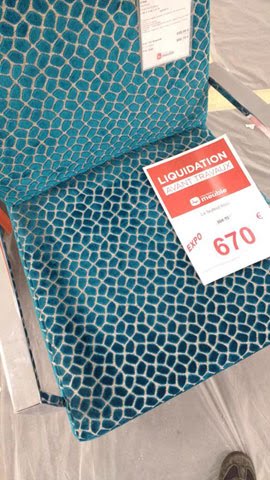 © Vincent Pantaloni Monsieur Meuble has an extensive social media presence on Facebook and YouTube, but not on Twitter (just four tweets!). Tantalisingly, the banner picture on YouTube, as of this January 2020 writing, has another possible Cairo tiling, but the resolution is so small as to be uncertain! It was ever thus...
Monsieur Meuble (excerpted from their history page) Monsieur Meuble, 40 years in the service of furniture Founded by a merchant from Saint-Etienne in 1959, the parent organization was originally a group of independent stores in the form of a cooperative company - the Union Franco Européenne du Meuble (UFEM) - whose objective is to allow customers to access quality furniture at a more affordable price. Very quickly based in Paris, in the 17th arrondissement, the beginnings of the organization behind Monsieur Meuble brought together 11 people. Since January 1971, the company has continued to develop, notably by acquiring a commercial brand: Monsieur Meuble. Today, nearly 120 brands are installed in France and offer a common offer, for all customers who embark on an interior design project. Backed by a network of brands throughout France, Monsieur Meuble's ambition is to be a strong brand in the mid-range high-end furniture sector. Further, the company has not expanded beyond France.
Acknowledgements Vincent Pantaloni, for drawing this to my attention in a tweet of 17 May 2017.
https://www.monsieur-meuble.com/notre-histoire/ https://www.youtube.com/channel/UCeHCd65bPSZuRnvaNHZ89uQ
Entry History Original, three-line entry 27 July 2017. Revised and greatly expanded entry of 28 January 2020. Modular Coffee Table, 'Nexus', by Pont des Arts An instance of a coffee table, titled ‘Nexus’, from Pont des Arts, Paris, France, who describe themselves as ‘Interior Design & Manufacturer.’ Pont des Arts (translated ‘Bridge of Arts) was founded by the Franco-Lebanese architect and designer Monzer Hammoud. Of note is that, unlike other entries on this table page (and Miscellaneous page), this is of a four-unit combined par hexagon pentagon, with the premise of the possibility of a modular arrangement into the Cairo tiling, as indeed is shown, with an ‘open central hexagon’ (and other configurations not shown). The table is one of a range of 79 and is available in a single size, 52 x 43 x H 50cm, price unknown. It is not known when it was introduced into their range, but as the company was formed in 2006, it is thus relatively recent. Details are scant as to the table in their promotional literature, with ‘Nexus. Coffee Table. Brass & marquetry wood. 52 x 43 x H 50’. Such brief descriptions are not just here, but also apply to their other tables. Shown here is a modular possibility, as exemplified by the photos. How successful this has been is unclear; certainly, I have not seen this outside of the company. Of note is that the company also have a related table, titled ‘Nexus 2’, of the same dimensions, of brass and marble, consisting of the par hexagon element, without the interior pentagons being demarked.
No mention of the connection as to the Cairo association is made on their site and so I thus contacted the company with a 2 November 2017 email to determine the matter (amid other queries). Hammoud told me: I knew the pavement of Cairo “Cairo pentagonal tiling” … I lived one year in Cairo. No other detail was forthcoming. From this, albeit limited detail, the idea seems to have arisen from seeing the paving in Cairo.
Pont des Arts have a suitably sized, non-searchable website, and is active on social media to a degree with Pinterest, but not elsewhere. The size of the company is unclear, although it appears to be a single-person concern. Whether Pont des Arts/Hammoud manufacture the furniture themselves is unclear. In this regard, reference is made to ‘highly trained crafts people’, which seems to imply employees, or outsourcing.
Background (From their ‘About’ page. Little background detail as to the company or Hammoud himself is given). Minor errors in spelling and capitalisation are corrected. Founded in 2006, Pont des Arts Studio established their STUDIO DESIGN in Paris, to meet the demand for their Interior Design in the luxury furniture sector. Over the years Pont des Arts Studio has built a reputation for producing a very high standards Furniture & Lighting. The success of Pont de Arts is down to a simple philosophy. This new collection presented of jewelry furniture and lighting is a culmination of international references and a desire to offer a dream range of object created from noble materials: gold, brass, silver, nickel and crystal. This unique collection is equally harmonious in a modern or classic interior. The quality of Pont des Arts objects is the result of two forces thought incompatible: Artisanaly crafted and modern design ARTISANAL because the object is crafted by hand: for example 3000 crystal beads assembled by experienced and highly trained crafts people. MODERN because our specialists use state of the art tools, such as laser cutting technology. Pont des Arts is a fresh brand with beautiful designs.
http://www.pontdesarts.biz/category/furniture/center-table/ Entry History Original three-line entry (excluding title, link and copyright) 3 November 2017. Revised and greatly expanded on 30 January 2020. 'Screen Dividers' 1, Exhibition Stand, by Institute for Lightweight Structures and Conceptual Design (ILEK), Stuttgart, Germany https://www.dezeen.com/2009/05/20/3d2real-by-ilek-students/ ‘Screen Dividers’ 2, Shinsegae’s Gangnam Store in Seoul, South Korea Shinsegae’s Gangnam Store in Seoul, South Korea, in association with the New York-based retail design firm Jeffrey Hutchison & Associates have used the Cairo tiling extensively as what can best be called ‘screen dividers’, of 2017. This is described by Eric Feigenbaum, writing in VMSD (Visual Merchandising Store Design) as: Bees to Honey In celebration of the 15th anniversary of Shinsegae’s Gangnam store in Seoul, South Korea, the upscale department store partnered with New York-based retail design firm Jeffrey Hutchison & Associates to redesign the store’s shoe salon. Envisioning a central women’s area that would be recognized as the “new world of shoes,” the footwear department was created to unify multiple shoe areas positioned throughout the location. The design solution helped expand the department by 20,000 square feet, while seamlessly accommodating more than 140 different shoe brands. With all of these elements in mind, the design team created the “hive” as a reference to a community gathering. “We wanted a central space on the floor, a hub evoking a sense of community,” explained Jeffrey Hutchison, owner, Jeffrey Hutchison & Associates. … Pentagonal, honeycomb-like screen dividers, reflective of a beehive’s geometry, are positioned at the edges of the center space, serving as a common thread that holds the five vocabularies of the individual rooms together. Each room has its own material palette, thereby enhancing and defining the nuances of each product offering... As can be seen, there is little reference to pentagons here, never mind the Cairo tiling. Further, one could question the use of ‘honeycomb-like’ here to describe the pentagonal cells. Honeycombs are strictly hexagonal, and so ‘honeycomb’ cannot thus apply to the Cairo tiling, but Feigenbaum qualifies this with the word ‘like’. Whether he is aware of the differences is unclear. I have seen such a description applied to the Cairo tiling elsewhere. Given the lack of reference made to the pentagonal tiling, and indeed seeking more information and picture permissions, I emailed Jeffrey Hutchison & Associates on 31 December 2019, but disappointingly did not receive a reply. Therefore, whether the use of the Cairo tiling is purposeful or accidental, the latter in the sense of a generic pentagon tiling is unknown. However, given the lack of reference, likely they are unaware of the association. As alluded to above, the angles and side lengths are not given. Further, it is not exactly clear who manufactured the screen and what material (it appears to be wood), but it is certainly impressive! Jeffrey Hutchison & Associates has a suitably sized website but is not searchable. Background (Excerpted from profile page) Today Jeffrey Hutchison & Associates boasts an impressive list of worldwide projects for clients such as Shinsegae International (Seoul), Palacio di Hierro (Mexico City), Saks Fifth Avenue, Barneys New York, Donna Karan, Theory, Ralph Lauren, Loewe, Narciso Rodriguez, Ann Taylor, Nautica, Girbaud, Façonnable, Dooney & Bourke, HMX and Bloomingdales. https://jeffreyhutchison.com/project/shinsegae-shoe-salon/ (pictures only; no pentagon discussion in the text) https://www.vmsd.com/content/bees-honey (by Eric Feigenbaum) Entry 16 January 2020 Modular Coffee Tables Although it may be thought unnecessary to define a coffee table, upon seeing how there exist much more table types than I first thought, of which homestratosphere.com lists an impressive 20, I now explicitly state its characteristics: Wikipedia Coffee tables are usually found in the living room or sitting room. They are available in many different variations and prices vary from style to style. Coffee tables may also incorporate cabinets or drawers for storage. The most common construction of coffee tables is out of wood (though faux wood tables are increasingly common); metal, glass, and leather coffee tables are also popular. Typically, stainless steel or aluminum are used for metal coffee tables. The idiom "Gather round the coffee table" is derived from the furniture piece and its proclivity for encouraging conviviality and light conversation. Coffee tables were thought to initially be constructed in Renaissance England. Modular Coffee Table 1, by Francesco Caracciolo di Marano and Sam Robin, founders of Robicara company, US An instance of a coffee table, titled ‘Pentagon’, from Robicara, founded by Francesco Caracciolo di Marano and Sam Robin, of Miami, Florida, US, who describe themselves as an ‘Art & Luxury furniture brand’. Of note is that, unlike other entries on this Miscellaneous page, this is of a single Cairo pentagon, with the premise of the possibility of a modular arrangement into the Cairo tiling (and other configurations, including a ‘central’ hexagon), as indeed is shown by the company. © RobicaraThe table is one of a range of ten, and is available in two sizes: W: 36” D: 24”, H: 16” and W: 48” D: 34”, H: 16”. Curiously, there is height discrepancy in some photos, although oddly identical height sizes are given. A caption as to the introduction gives a date of 12 November 2015. This is briefly described on their site: These beautiful [coffee] tables can be arranged in numerous layouts making them a perfect fit in any interior. Implied here is a modular possibility, as exemplified by the photos. How successful this has been is unclear; certainly, I have not seen this outside of the company. No mention of the connection as to the Cairo association is made on the site or their social media (or at least as I can establish), and so I thus contacted the company with a 13 November 2017 email to determine the matter (amid other queries). However, although di Marano replied this aspect went unresolved, my mail being answered generally with: we played with hexagon and pentagon on our design... Likely, they were unaware of this association. Robicara has a suitably sized, searchable website and is active on social media, especially on Facebook, Instagram, and Pinterest, but less so on Twitter. The size of the company is unclear. It appears to be a two-person concern. Whether di Marano and Robin manufacture the furniture themselves is unclear. In this regard, reference is made to ‘craftspeople’, which seems to imply an (in house) outsourcing, with employees. Background (from their Facebook page) Robicara a world where beauty and functionality, practicality and pure indulgence are in perfect harmony. Robicara is a company whose craftspeople make, often by hand and always with love, furniture and accessories. A division of Sirio established in the late 90’s by the designer Sam Robin and award winning furniture designer Francesco Caracciolo di Marano. Robicara’s development is ever changing. Devoted to creative research and the love for attentive detail their pieces exalt the harmony of human habitation and the natural world. The perfect mix between design and craftsmanship. Most of Robicara pieces are completely hand made. Creating tailored made furniture, customized with finishes and materials to suit. Acknowledgements Francesco Caracciolo di Marano, for a reply and photo permissions. http://robicara.com/galleries/pentagon-coffee-table/ http://robicara.com/wp-content/uploads/2019/01/pentagon.pdf Original four-line entry of text, link and picture 14 November 2017. Revised and greatly expanded entry 29 January 2020. Modular Coffee Table 2, by Frövi An instance of a coffee table, titled ‘Nest’, from Frövi, who describe themselves as ‘a family owned British furniture company with a name inspired by Scandinavian design’. Of note is that, unlike other entries on this Miscellaneous page, this is of a single Cairo pentagon, with the premise of the possibility of a modular arrangement into the Cairo tiling (and other configurations, including a ‘central’ hexagon). This is described in their catalogue (seemingly dual with a related seat, below), p. 113, as: A truly configurable seating option - this geometric design is adaptable to any workspace, allowing creativity with color and shape as it can be nested together to create infinite combinations. It works as individual pieces or in modular layouts to create waiting, working or relaxing environments. Therefore, it lends itself to a host of applications across corporate or hospitality marketplaces.
Coffee Table Office View, left, Detail right Note also that Frövi has an accompanying seat, placed as a separate entry. Arguably this could (and should) be combined. However, as other (modular) entries for tables and seats are one-offs, I thus differentiate. Incidentally, despite the company beginning in the UK, from 1976, I was unaware of them before this entry! They have an impressive, searchable website, with catalogues made freely available, and have an extensive social media presence, including all the ‘big five’. Quite when this was introduced into their range is unclear. However, seeing as this is of the most recent catalogue, likely it is recent, loosely defined, and not old, from the beginning of the company in 1976. As I have found, like other products, each seems to have a natural lifespan before being discontinued upon a production run, in favour of the new. No mention of the connection as to the Cairo association is made on the site or their social media (or at least as I can establish), and so whether the use of the Cairo tiling is purposeful or accidental, the latter in the sense of a generic pentagon tiling is unknown. Likely, as this is not mentioned, they are unaware of this association. I did not contact the company, judged that they would likely not respond, fairly or unfairly, of a non-commercial query. Background Frövi is a British furniture company with a name inspired by Scandinavian design and ethos and were formed in 1976. Although designers names are given, it is not clear who began the company, and who effectively runs this of the present day. As market-leading manufacturers, they only use high-quality materials and invest in cutting-edge technology to create premium designs at their design studio in Oxfordshire and factory in the Cotswolds. Built for commercial environments, each piece of furniture is formulated to be robust, with the premise that every piece will deliver on quality, strength and value. Acknowledgements Vincent Pantaloni, for drawing this sighting to my attention in a 4 January 2020 Twitter post by David Swart, which featured the seat, but not the coffee table. https://frovi.co.uk/product/soft-seating/nest/ Entry 8 January 2020 Modular Coffee Table 3, 'Penta', by Studio Kees Marcelis An instance of a coffee table, titled ‘Penta’, from Studio Kees Marcelis, of Arnhem, Gelderland, Netherlands, who describe themselves as ‘is a studio for (interior) architecture and design’. Of note is that, unlike other entries on this Miscellaneous page, this is of a single Cairo pentagon, with the premise of the possibility of a modular arrangement into the Cairo tiling, as indeed is shown (and other configurations not shown, including an ‘open central hexagon’). Somewhat curiously, I could not find even the slightest of references to the table on their website! The tables are marketed on Odesi, a Netherlands interior design company (although again I could not find the tables!). However, it is described in detail on the Woonhome website (loosely describing themselves as ‘... the online platform where you can compare new and second-hand furniture and home accessories’, of a February 1, 2017 posting, with presumably detail supplied by Marcelis: The materials steel and porcelain come to strengthen the collection of the furniture and design brand Odesi. These materials are reflected in the new Penta: a coffee table that you can transform into a side table. The five corners are characteristic of the design of the coffee table. Because of this special shape you can combine the tables in countless ways. For example, make one large (or long) coffee table of four parts. Use one table as a special side table next to your armchair or in the corner of the room. The possibilities are endless. The tabletop is made of porcelain with a beautiful relief. This high-quality type of pottery comes from Italy and is sustainable in nature. The porcelain is resistant to frost, heat, scratches and stains. Special maintenance is not required, making the Penta coffee table very practical. The base of the coffee table has also received all the attention. This is made of steel and finished with a black lacquer. The round legs give an elegant balance to the design and the pentagonal shape returns as a slide on the floor. In addition, the tabletop is reinforced on the underside and also entirely of steel. The Penta coffee and side table can be ordered in four colors of porcelain: Biacca, Fog, Dry and Dark. All colors form a nice contrast with the frame and can be nicely combined with each other. This way you create a subtle playfulness in your living room. Kees Marcelis is the designer of the Penta coffee table. He has been working professionally in the field of architecture, interior design and design for over twenty years. His starting point when designing furniture is to always make something special. The creative freedom he takes for this can be seen in his furniture designs. Watch the video in which Kees Marcelis tells more about the Penta design table. Studio Kees Marcelis has an impressive, albeit non-searchable website, and a social presence on Facebook, Instagram, Pinterest and LinkedIn (but curiously not Twitter). The table has attracted considerable critical acclaim on design sites and was exhibited at the Dutch Design Week in 2016 by Marcelis himself, and of which he discusses in a video (in Dutch). No mention of the connection as to the Cairo association is made on their website or their social media (or at least as I can establish), or indeed on exterior sources, and so whether the use of the Cairo tiling is purposeful or accidental, the latter in the sense of a generic pentagon tiling is unknown. Likely, as this is not mentioned, they are unaware of this association. I did not contact the company. Background (from their LInkedIn page) Kees Marcelis is an interior designer for more than twenty years. In all these years he has developed a particular, personal style. Award nominations and prizes over the years, such as the Architecture Price Achterhoek 2009, his nomination for the Dutch Design Prize 2005 and the Bathroom Design Award in 2006, succeed in generating interest among the home design media, trade press and newspapers, resulting in numerous articles and interviews. Recently the magazine Esquire mentioned Kees Marcelis in the top twelve of best Dutch interior designers. Kees Marcelis’ interest is not so much in the awards, but rather in the people he designs for. As well as in his designs, he also manages to share his fascination for the designers’ trade as a teacher and in his lectures. https://www.archiexpo.com/prod/odesi-dutch-design-online/product-71018-1793236.html https://www.woonhome.nl/wooninspiratie/design-salontafel-penta-van-staal-italiaans-porselein/ https://youtu.be/Z74KzcZ3hAE (51 seconds, in Dutch) Entry 9 January 2020 Modular Coffee Table 4, Dsignio/Beltá & Frajumar An instance of a (lightweight) table, titled ‘Pent Table’, a collaboration of c. 2014, between Spanish concerns Dsignio, an Integral Design Studio and Beltá & Frajumar, a furniture and upholstery manufacturer. Quite how best to attribute the design too is unclear. It appears to be of a broad equal collaboration, albeit with Dsignio leading as to the design, with Beltá & Frajumar then implementing. Further, quite how best to describe this is unclear. It is simply titled ‘table’ by Beltá & Frajumar, without further ado. However, as it is very much like of a coffee table in appearance, I have thus decided to place under this specific category, albeit with due reservation. Of note is that this is the second of four Cairo tile themed furniture pieces from Beltá & Frajumar, under the same ‘Pent’ title, with others being another more substantial table, an armchair and a pouffe/ottoman. Each of these is shown as a separate entry. The geometry, albeit not stated, all appears to be the same in all instances. Of note is that, unlike other entries on this Miscellaneous page, this is of a single Cairo pentagon, with the premise of the possibility of a modular arrangement into the Cairo tiling (and other tiling configurations, including a ‘central’ hexagon). Some of the entries on Beltá & Frajumar are more explicit as to this possibility than others. Here the table is shown in isolation. Hence perhaps this wasn’t intended to be modular but was to complement the range. Whatever, as it is a possibility, I have decided to include here nonetheless for the sake of completeness. The table is described rather briefly by both Dsignio (generically) and Beltá & Frajumar (generically and specifically): Dsignio Pent is the new table that DSIGNIO has designed for Beltà. It is a modular system consisting of a pentagonal piece that can be repeated, creating countless compositions. It is a kind of puzzle to play with, looking for the result that best suits your needs. Its size has been studied to also be used as a seat, forming dynamic sets that fit different users. The finish of the pieces in natural ash provides warmth and, due to the morphology of the modules, a type of timeless design is achieved. You can also create more fun compositions using lacquer ware in different colors. And in an interview with ‘Design Daily’: We just designed dozens of grids (I love geometry) and we thought that one of them could be a modular table”. Beltá & Frajumar Beltá & Frajumar in their catalogue, discuss this in two parts, first, a generic discussion as to the Pent range, and second specific detail, of the furniture, be it table, armchair or pouffe as below: Pent is a modular system consisting of pentagonal pieces that can be repeated creating countless compositions. It is a puzzle with which to play in order to create the shape that best suits ones needs. The possibilities are endless, including use as an ottoman. and 2. Table. Frame of steel rods, and oven dried epoxy paint. Solid wood pentagonal top stained to different colours according to the table frame. The side lengths are incompletely described, with only a 60cm base given, whilst the angles are not given. Dsignio has a design-led website, but is not searchable, and have a social media presence on Twitter and Facebook. Many more photos can be found on their photo page of the latter. Beltá & Frajumar, befitting their status, has an extensive website, in Spanish, English and French and is searchable, and have an extensive social media presence on Twitter, Facebook, Pinterest, YouTube, Instagram and LinkedIn. Of note is that Dsignio has a decided liking for the Cairo tiling. They have also used it for the Peronda Group, with KIN ceramic wall tiles (see dedicated page), as well as the collaboration with Beltá & Frajumar. No mention of the connection as to the Cairo association is made on either Dsignio or Beltá & Frajumar sites. Upon previous correspondence on the KIN ceramic wall tile instance (10 April 2015), in which I mentioned the Cairo connection, Patxi Cotarelo told me: It was the first time I read about the Cairo tiles, thank you for the information, it was interesting. From this, they were obviously unaware of the association, it was found by chance, as an instance of aesthetic geometry/design. Almost certainly, with Disgnio leading, Beltá & Frajumar, also has no knowledge of the Cairo tiling. An open question is to how well this has sold. As such, I have not seen any instances other than in the catalogue. Background DSIGNIO is an Integral Design Studio located in Madrid that executes international projects. It was founded by Alberto Bejerano and Patxi Cotarelo in 2002, both of them Technical Engineers of Industrial Designs and Interior Design Master. Throughout these years DSIGNIO has received several awards, highlighting three nominations for best design of the year in Spain in the last edition of the Delta awards. DSIGNIO have designed products for different companies that sell DSIGNIO´s designs in over 60 countries and exhibited them at fairs such as Milan, Paris, Moscow, Singapore and London. DSIGNIO’s projects are published frequently in the specialized press, in general media and in more than 500 design blogs. They also give lectures and courses at universities in Spain, Japan and Mexico. Beltá & Frajumar, of Yecla, Murcia, Spain, and founded in 1967, is a furniture and upholstery manufacturer for the hospitality and living sector. Born from the will of standing up for design and innovation, Beltá & Frajumar has the goal of manufacturing singular and unique objects. Each product that is developed has to keep a harmonious relation with everything it is surrounded by, the places it is used in and the users. https://designdaily.in/the-very-versatile-pent-table-dsignio/ (includes interview) https://beltafrajumar.com/en/product/pent-table/ (peripherally referenced) Entry 13 January 2019 Modular Table 1, by Dsignio/Beltá & Frajumar, 'Pent Table' An instance of a table, titled ‘Pent Table’, a collaboration of c. 2014, between Spanish concerns Dsignio, an Integral Design Studio and Beltá & Frajumar, a furniture and upholstery manufacturer. However, quite how best to attribute the design is unclear. It appears to be of a broad equal collaboration, albeit with Dsignio leading as to the design, with Beltá & Frajumar then implementing. Further, quite how best to describe this is unclear. It is simply titled ‘table’ by Beltá & Frajumar, without further ado. However, I have concerns about this. A table to me has legs, and is defined (Oxford Dictionary) as such: a piece of furniture that consists of a flat top supported by legs This clearly does not have legs, and so I am wary of the description. It appears more of a seat or bench (and indeed in the text is referred to as such). However, I have thus decided to place under this specific category, given the title, albeit with due reservation. Photo by Beltá, left; Photo by Dsignio and Beltá, right. Of note is that this is the first of four Cairo tile themed furniture pieces from Beltá & Frajumar, under the same ‘Pent’ title, with others being another, more lightweight table (what I title as a coffee table), an armchair and a pouffe/ottoman. Each of these is shown as a separate entry. The geometry, albeit not stated, all appears to be the same in all instances. Of note is that, unlike other entries on this Miscellaneous page, this is of a single Cairo pentagon, with the premise of the possibility of a modular arrangement into the Cairo tiling (and other tiling configurations, including a ‘central’ hexagon). Some of the entries on Beltá & Frajumar are more explicit as to this possibility than others, as here. The table is described rather briefly by both Dsignio (generically) and Beltá & Frajumar (generically and specifically): Dsignio Pent is the new table that DSIGNIO has designed for Beltà. It is a modular system consisting of a pentagonal piece that can be repeated, creating countless compositions. It is a kind of puzzle to play with, looking for the result that best suits your needs. Its size has been studied to also be used as a seat, forming dynamic sets that fit different users. The finish of the pieces in natural ash provides warmth and, due to the morphology of the modules, a type of timeless design is achieved. You can also create more fun compositions using lacquer ware in different colors. And in an interview with ‘Design Daily’: We just designed dozens of grids (I love geometry) and we thought that one of them could be a modular table”. Beltá & Frajumar Beltá & Frajumar in their catalogue, discuss this in two parts, first, a generic discussion as to the Pent range, and second specific detail, of the furniture, be it table, armchair or pouffe as below: Pent is a modular system consisting of pentagonal pieces that can be repeated creating countless compositions. It is a puzzle with which to play in order to create the shape that best suits ones needs. The possibilities are endless, including use as an ottoman. and 1. Table in MDF frame with ash wood veneer with mitre joints in each face. The side lengths are incompletely described, with only a 60cm base given, whilst the angles are not given. Dsignio has a design-led website, but is not searchable, and have a social media presence on Twitter and Facebook. Many more photos can be found on their photo page of the latter. Beltá & Frajumar, befitting their status, has an extensive website, in Spanish, English and French and is searchable, and have an extensive social media presence on Twitter, Facebook, Pinterest, YouTube, Instagram and LinkedIn. Of note is that Dsignio has a decided liking for the Cairo tiling. They have also used it for the Peronda Group, with KIN ceramic wall tiles (see dedicated page), as well as the collaboration with Beltá & Frajumar. No mention of the connection as to the Cairo association is made on either Dsignio or Beltá & Frajumar sites. Upon previous correspondence on the KIN ceramic wall tile instance (10 April 2015), in which I mentioned the Cairo connection, Patxi Cotarelo told me: It was the first time I read about the Cairo tiles, thank you for the information, it was interesting. From this, they were obviously unaware of the association, it was found by chance, as an instance of aesthetic geometry/design. Almost certainly, with Disgnio leading, Beltá & Frajumar, also has no knowledge of the Cairo tiling. An open question is to how well this has sold. As such, I have not seen any instances other than in the catalogue. Background DSIGNIO is an Integral Design Studio located in Madrid that executes international projects. It was founded by Alberto Bejerano and Patxi Cotarelo in 2002, both of them Technical Engineers of Industrial Designs and Interior Design Master. Throughout these years DSIGNIO has received several awards, highlighting three nominations for best design of the year in Spain in the last edition of the Delta awards. DSIGNIO have designed products for different companies that sell DSIGNIO´s designs in over 60 countries and exhibited them at fairs such as Milan, Paris, Moscow, Singapore and London. DSIGNIO’s projects are published frequently in the specialized press, in general media and in more than 500 design blogs. They also give lectures and courses at universities in Spain, Japan and Mexico. Beltá & Frajumar, of Yecla, Murcia, Spain, and founded in 1967, is a furniture and upholstery manufacturer for the hospitality and living sector. Born from the will of standing up for design and innovation, Beltá & Frajumar has the goal of manufacturing singular and unique objects. Each product that is developed has to keep a harmonious relation with everything it is surrounded by, the places it is used in and the users. https://designdaily.in/the-very-versatile-pent-table-dsignio/ (includes interview) https://www.archiscene.net/design/pent-table-dsignio/ https://beltafrajumar.com/en/product/pent-table/ Entry 10 January 2020 People People 1. Maurits C. Escher, Periodic Drawings and Sketches First, quite best how to categorise Escher’s entry is unclear, as there are various ways of discussing this. Given his preeminence in tessellation matters, I have decided to place as according to the person himself, rather than diluting his contribution under, say, artworks per se. Maurits C. Escher (1898-1972) made extensive use of the Cairo tiling in his artworks, in various ways, first as sketches, of 1937 (of both the tile itself and representational motifs), and second as periodic drawings, prints and ceramic tiles, 1967-1968, and so all of which makes for a trying task in unravelling as a body of work. Matters are further complicated by outside influences, namely by papers by Friedrich Haag, a German pioneering crystallographer, which inspired Escher, detailed below. With so many vagaries here, this is not a straightforward task. For instance:
Detailing all the aspects here is a task that would take many days, if not weeks, of which for the premise of this page would be somewhat excessive. Therefore, I have thus decided to include the works on paper, and not ceramics (the latter of which I discuss separately, as wall tiles). Possibly a more succinct, and cohesive approach would be to differentiate between the sketches and periodic drawings, but I have decided to include both here in the discussion, albeit separated by each period of study. However, I have not unduly been slipshod or too succinct in my approach to the point of confusion or of a worthless piece of writing. Rather, I have simply compiled a piece as deemed appropriate. Undoubtedly, it can be improved at a later sitting, but to at least establish Escher’s contribution, it more than suffices. It should be stated at the onset that Escher's studies predate the modern-day attribution of this tile, of 1971, by James Dunn, and so he obviously did not associate the tiling directly with the term ‘Cairo’ in any way. Although the Cairo tiling first appeared in 1957, it was not titled as such or was known beyond Egypt, and so it is inconceivable that Escher knew of its earlier use in Cairo itself. Although Escher did not discuss this tiling in any way, one can nonetheless thus infer that it was one of his favourite (non-representational) tilings, given the relative extensive usage he made of it, and so likely he was attracted by its aesthetic features. Escher's studied the Cairo tiling in two distinct periods, of the 1937 and 1967-1968. These differ considerably in approach. The 1937 studies are essentially sketches, in combination with other studies, whilst that of 1967-1968 was that of finished, numbered periodic drawings, in preparation for other works (save for an interlacing instance), namely for Metamorphosis III and ceramic tiles. Regrettably, although Escher did not discuss this tiling in any way, one can nonetheless thus infer that it was one of his favourite (non-representational) tilings, given the relative extensive usage he made of it, and so likely he was attracted by its aesthetic features. I begin by separating the two different periods of study by Escher, as according to chronological order, given that he studied this at distinct dates, namely 1937 and 1967-1968. Unfortunately, the latter is somewhat inconvenient to unravel (at least given the time I want to devote to it), given that variations of a theme are used. Unfortunately, some ‘early’? sketches were not dated, of which I am decidedly unsure as to their chronology. Period 1, 1937 The roots of this interest date back to 1937 when Escher studied a series of papers by Haag of, ‘Die regelmässigen Planteilungen’ [3], ‘Die regelmässigen Planteilungen and Punktsysteme’ [4] (Regular Divisions of the Plane and Point Systems), and ‘Die pentagonale Anordung von sich berührenden Kriesen in der Ebene’ [5]. These were included on a list of * articles as given by Beer, his half brother. In the course of this as a general study, Escher tried his hand at reproducing his diagrams, along with experiments of his own (Schattschneider pp. 28-29). Some of the diagrams in the paper resemble the Cairo tiling, namely p. 487 [4], but with the aid of a German translation, I have established that this was not of a Cairo tiling, at least of this paper. [5] shows a Cairo tiling in the context of circle packing, which further confuses matters. Sketches of these derived studies appear in Schattschneider [1], pp. 28-29. P. 106 also shows a sketch, of scarabs and butterflies. Period 2, 1967-1968 Instances of periodic drawings include, with Schattschneider's titles: No. 131, Pentagon with Flower, December 1967 No. 132, Flower, December 1967 No. 133, Interlaced Hexagon, December 1967 No. 134, Flower, December 1967 No. 136, Two Tile Pairs, 1968 A curiosity here is Schattschneider’s titles. Drawings 131 and 132, essentially the same save for minor differences, both show ‘pentagons with flowers’, but are not titled in tandem as such. As these form a series; possibly the prefix pentagon is assumed. Nos. 131/132 were created for the express purpose, of ‘extensions’ to the much earlier (1937) Metamorphosis II print, of Metamorphosis III, of the same year. No. 133 appears to have been a study in its own right, of interlacing hexagons in the Cairo configuration, with no subsequent usage. No. 134 was for a ceramic tile, as was essentially the same tiling, 136. The explanation for the missing drawing 135 was that it was an inadvertent omission. For convenience, I repeat Schattschneider’s, excellent, detailed commentary of each periodic drawing: ESCHER NO. 131 [PENTAGON WITH FLOWER] Drawn at Baarn, December 1967 Ink, watercolor 200 X 200 mm (image); 300 x 235 mm (sheet) Escher system “related to VIII”; Symmetry group p4g Related work: Metamorphosis III 1967-68 (cat. 446) See drawings 131, 134, and 136. Related work: Design developed for tiled column for New Lyceum in Baarn (see drawings 134 and 136) On this drawing, Escher refers to drawings 42 and 43, both of which have designs of stars and diamonds as their source. The geometric design shown with the notes on drawing 42 is also the basis for this drawing: The stars become flowers and the fused diamonds form the crosses of leaves. With this interpretation, the pattern is one of three separate motifs—leaves black and flowers white. But Escher traces a grid of congruent pentagons, and this single shape with its embossed flower creates the same plane filling. Escher chose this for a new panel in Metamorphosis III, which added a new "chapter" at the outset of that picture story (see page 258). The checkerboard squares deform like a collapsible rack and produce a new mosaic of squares and diamonds; the diamonds sprout new points and divide into stars; stars become flowers (with bees seeking their pollen), and then the process reverses until the checkerboard is again restored. ESCHER NO. 132 [FLOWER] Drawn at Baarn, December 1967 Ink, watercolor 281 X 200 mm (image); 300 x 230 mm (sheet) Symmetry group p4g Related work: See drawings 131, 134, and 136 This is a second version of drawing 131, in which Escher has added red and blue to the pentagon grid and to the centers of the flowers. The single square shown at the bottom of the drawing can create the plane filling by means of translations alone; this was quite likely a proposed design for one of the tiled columns for the New Lyceum in Baarn. The introduction of color not only enlivens the design, but also adds color symmetry. ESCHER NO. 133 [INTERLACED HEXAGON] Drawn at Baarn, December 1967 Ink, watercolor 203 X 203 mm (image); 305 x 227 mm (sheet) Symmetry group pgg Escher's fascination with multiple interpretations of a single geometric design is apparent in his series of drawings 131 to 134. In drawing 133, Escher removes the flowers from drawing 132 and focuses on that pattern's two overlapping hexagonal grids, one red and one blue. Here, he makes the hexagonal grids white and black and interweaves them against a gray background. The over-under interlacing destroys the 4-fold symmetry present in the earlier version, but the other symmetries remain. ESCHER NO. 134 [FLOWER] Drawn at Baarn, December 1967 Ink, watercolor 278 x 203 mm (image); 302 x 227 mm (sheet) Symmetry group pgg Related work: Design for tiled column for New Lyceum in Baarn, 1968. Porcelain tiles by Porceleyne Fles (Delft); column diameter 60 cm, height 260 cm. In this drawing, Escher combines the interlacing of the hexagons in drawing 133 with the flower patterns in drawings 131 and 132 and turns the pattern 45° so that the hexagons are aligned horizontally and vertically. For both practical and aesthetic reasons, this pattern is more suited to cover a vertical column. At the bottom of the page, Escher has drawn the two squares for tiling the column in the Baarn school (see drawing 136). ESCHER NO. 136 [TWO TILE PAIRS] [Drawn at Baarn, 1968] Ink, watercolor 305 X 237 mm (image); 305 x 237 mm (sheet) Published (in part) in Art and Science. Related work: Designs for two tiled columns for New Lyceum in Baarn, 1968. Escher sent this design drawing to the Delft manufacturer of the tiles for two columns to be covered with the periodic designs in drawings 126 and 134. Only one tile mold was required for the design of birds and fish, but the single tile had to be glazed in both positive (A1) and negative (A2) versions. Each tile contains two birds and two fish (in pieces) in direct and in mirror image. At the top of the drawing, Escher notes that now the eyes of the white fish are good; the mistake noted in drawing 126 has been corrected. The simpler design of flowers also required two versions (B1 and B2) due to the "woven" strips and the curvature of the tiles. The tiles are 233 x 233 mm; the tiling on each column is 11 tiles high and 8 tiles around. Escher's tiling scheme for each column is at the bottom of the page. An open question is to what type of pentagon Escher used, in terms of side lengths and angles. Previously, I was somewhat hindered in my investigation, in that the reproductions of his tilings, primarily in Visions of Symmetry did not show satisfactorily the squared grid paper he used, and so I could not determine the exact proportions of the stick crosses he used to form the tiles. However, the book M. C. Escher’s Universe of Mind Play [2], at least of drawing 133 (p. 109), does permit this to be discerned. Here, the pentagons are of long sides with a short base, with angles of * and *. It would appear that all the other instances are likely the same. References:
Books [1] Schattschneider, Doris. Visions of Symmetry. Notebooks, Periodic Drawings, and Related Work of M. C. Escher. New York. W. H. Freeman and Company, 1990. Revised edition, 2004
[2] Various. M. C. Escher’s Universe of Mind Play. Odakyu Department Store. First edition, 1983 Escher Cairo tiling periodic drawings 131-134, 136-137, pp. 106-110.
Articles
[3] Haag, F. ‘Die regelmässigen Planteilungen’. Zeitschrift fur Kristallographie 49 (1911): 360-369. Although this has what can be interpreted as ‘skewed Cairos’, there is not a standard Cairo tile here. Note that this article was the first of three by Haag on a listing of B.G. Escher as given to M. C. Escher (as documented in Visions…, p. 357). N.B. ‘regelmässigen’ in the title is lower case as in the original and is not a typo on my part.
[4] ————. ‘Die regelmässigen Planteilungen und Punktsysteme’. Zeitschrift fur Kristallographie 58 (1923): 478-488. This is the article Doris Schattschneider quoted me as a Cairo tiling, fig 13, p. 487 in her tiling listserver response to my posting. However, after a translation was obtained, this is not so, Haag is referring to a quadrilateral tile and not a pentagon; the pentagon ‘appears’ incidentally, upon a misinterpretation of the diagram. Note that this article was the second of three by Haag on a listing of B. G. Escher as given to M. C. Escher (as documented in Visions…, p. 357).
[5] ————. ‘Die pentagonale Anordung von sich berührenden Kriesen in der Ebene’. Zeitschrift fur Kristallographie 61 (1925), 339-340. Has Cairo tiling in the form of circle packing. Quoted in Bradley and Schattschneider. Entry 22 January 2020 People 2. Rinus Roelofs, Colour and Interlacing Sculptures Rinus Roelofs, of Hengelo, the Netherlands, is a mathematically inclined artist, a ‘digital sculptor’, who has used the Cairo tiling in various ways in his work, specifically of interlacing (primarily) and colouring (secondary). This is both explicitly, by the association with Cairo, and not, in which the source is Escher's related drawing 133, of ‘interlacing Cairo hexagons’ duly credited. His work in general mostly involves interlacing lattice structures. Four Cairo references are discerned (mostly without the association), three in print, and one on his website, with the titles given below, to which I add brief commentary, with bibliographical detail in the references. In chronological order: 1. 1998. ‘Tegels kleuren’. (Tiles colours) In the context of colouring per se, involving multiple colours. Here the association with Cairo is made, and incidentally for the only time. 2. 2005. ‘Not the Tiles, but the Joints: A little Bridge between M.C. Escher and Leonardo da Vinci’. In the context of interlacing lattice structures, with Escher’s drawing 133 redrawn, but without the Cairo association. 3. 2008. ‘Connected Holes’. Largely in the same vein as with ‘Not the tiles’, at least in appearance. Again, Escher’s drawing 133 is redrawn, but without the Cairo association. 4. The tiling also appears on his website, the dual of 33334, as an ‘elevation’. From the above, two distinct aspects are discerned, colouring and interlacing. Both are interesting. The colouring aspect is a discussion on the use of up to six colours. Interlacing is discussed in relation to Escher’s drawing 133, as a three-dimensional computer derived sculpture. Given Roelofs’s undoubted interest, I emailed him in August 2018 for further observations, but he did not respond. He has a pleasing, easily navigable website, but is not searchable. On social media, he has an extensive presence on Facebook, with many photos more conveniently accessible en masse than on the website, but not elsewhere. Biography (from arsmathematica.org) Rinus Roelofs was born in 1954. After studying Applied Mathemathics at the Technical University of Enschede, he took a degree from the Enschede Art Academy with a specialization in sculpture. His commissions come largely from municipalities, institutions and companies in the Netherlands, but his work has been exhibited further afield, including in Rome as part of the Escher Centennial celebrations in 1998. References [1] ‘Tegels kleuren’ (Tiles colours) in Pythagoras, April 1998, pp. 22-23. In Dutch. The Cairo tiling features as the main premise, on aspects of colouring. The article was part of a special issue dedicated to Escher, to mark his 100th birth anniversary. [2] ‘Not the Tiles, but the Joints: A little Bridge between M. C. Escher and Leonardo da Vinci’. In M. C. Escher’s Legacy. A Centennial Celebration. Springer 2005, pp. 252-264. Cairo related pp. 253-254. Refers to Escher’s periodic drawing 133, but not the Cairo tiling by name. [3] ‘Connected Holes’. In Bridges Leeuwarden. Mathematical Connections in Art, Music, and Science, 2008, pp. 29-38. Cairo tiling based (but not stated) on Escher’s (interlacing) drawing 133, pp. 29, 32-33 (p. 33 is wrongly captioned as to the underlying tiling ‘dual of 43433’). https://www.arsmathematica.org/is2003/3dsc/rinus_roelofs.htm (Biography) http://www.rinusroelofs.nl/projects/elevation-2d/pr-elev-2d-a05.html (‘Elevation’) https://archive.bridgesmathart.org/2008/bridges2008-29.pdf (Bridges 2008)https://pyth.eu/uploads/user/ArchiefPDF/Pyth37-4.pdf (‘Tegels kleuren’ article) Entry 23 January 2020 Acoustic Walls/Board/Panels Fluffo, Poland Fluffo, of Borzecin Duzy (near Warsaw), Poland, founded in c. 2014, is a relatively small company who describe themselves as a manufacturer and supplier of acoustic wall panels, of flexible, dense polyurethane foam, with the finish resembling velvet. They have an extensive website in Polish and an English option but is not searchable and a social media presence on Facebook, Pinterest and Instagram. They market the Cairo tiling (of a ten-panel range) as ‘Fluffo SOFT’, as wall panels only. The range is described: Fluffo SOFT is a collection of decorative, soundproofing wall panels, available in a wide selection of colours, shapes and thicknesses. They soundproof a room in a beautiful and stylish way. With Fluffo SOFT you can enjoy a cosy, quiet and most importantly, beautiful interior. This is primarily marketed in Poland, available directly from themselves or distributors as well as other European countries, but only as a token presence; the UK has only one supplier. The Cairo tiling is titled, curiously, as ‘Chain’, without reference to a pentagon tile (as an aside, quite how I found this is a mystery!), albeit is not strictly of a single pentagon, but is rather fused, of a (slight) incline, albeit differentiated by colour. It is available in 52 colours, of four blues, four yellows etc. The angles and side lengths are not stated, although the height and width are, 367 x 550 mm, with a thickness of 20-50 mm. It is not known when the Cairo tiling was introduced into their range. Given the widespread nature of the company, one would expect the tiles to feature in many homes, not just in Poland, but if so I have not seen any; all I have seen are as marketed, or supplied, by the company. No mention of the connection as to the Cairo association is made on the site, and so whether the use of the Cairo tiling is purposeful or accidental, the latter in the sense of a generic pentagon tiling is unknown. Likely they are unaware of this association. I did not contact the company, judged that they would likely not respond, fairly or unfairly, of a non-commercial query. Company details and background Fluffo, of whom the founder’s name and exact date (from a start around 2012 before a company as such about 2014) remain unclear, make a great play on that the panels were invented, designed and produced in Poland. The work, originally in their garage, on the implementation of their first collection of panels, mastering the technology processes and the creation of Fluffo marketing took almost 1½ years. The main part of the production process is done manually. The technological process – even though known for decades – is extremely difficult to automate. Since the founding, they have produced over 200,000 panels. The number of employees is not stated. No other relevant detail is given. http://fluffo.uk/en/at-home/fluffo-soft-soft-wall-panels Acoustic Wall, by Kamilla Lang Hermansen An instance of an ‘acoustic wall’, titled ‘Pentagon’, by Kamilla Lang Hermansen, now Kamilla Lang Betak, of Norway, who has a background in architecture and is now an Exhibition Architect at VejleMuseerne, Denmark. The acoustic wall is described by Betak on her Behance page (with minor corrections in spelling): Pentagon is a system of elements which, when put together, creates acoustic walls to reduce noise in open space offices or schools. Above, the elements also have a pattern, which is the same on each pentagon. The pattern is inspired by old Norwegian wood carving. As a trainee at mmw architects of Norway, I worked on the acoustic walls together with the young designers at StookeAustad [Design Studio] and the wood manufacturer Bosvik. The walls were created for the exhibition at Beyond Risør [a municipality and town in Norway] in June 2008. … the material inside the pentagons, which has a sound reducing effect. However, I have concerns here as to the project description. To me, this is not an (acoustic) wall as such, but rather a screen. Or perhaps it’s both; the pictures show another construct, of a solid nature. Who knows? Whatever, for now at least, albeit with reservations, I have decided to place under its title as given, and reference this as a screen in that particular section.
In short, with Betak leading the way, this was a collaboration, with two other partners, as above. However, beyond this, there are no other details. No mention of the connection as to the Cairo association is made on the page or elsewhere as far as I can tell. I contacted Betak on this and other matters, but she did not respond. Given the secondary role StookeAustad and Bosvik had, I did not contact them. As such, it appears to have been a one-off design project of Betak, not commercialised; it is seemingly not mentioned subsequently by StookeAustad or Bosvik, nor did she apparently pursue this.
The pentagon angles and dimensions are not given. However, they can be seen to be ‘near equilateral’ or indeed perhaps equilateral.
A curiosity here, and of potential undoubted historical interest is: The pattern is inspired by old Norwegian wood carving. The statement is somewhat ambiguous. By ‘pattern’, is Betak referring to the Cairo tiling or the sinuous inner decoration? Upon research, this would appear to be related to the decoration; Norway apparently has a tradition of wood carving, dating back to the Vikings. Therefore, it is not the pentagon, unfortunately!
Background
Kamilla Lang Betak There is seemingly little detail on Betak as a person. She does not appear to have a website as such. She has a presence mostly on Behance, and to a lesser degree on LinkedIn. She is on Facebook, but a friend request is in order to see details Her LinkedIn page gives: Exhibition Architect at VejleMuseerne, Horsens, Central Region, Denmark, followed by her experience, education and languages spoken.
Beyond Risør 2008 Beyond Risør 2008 was a Norwegian design exhibition, a forum to bring young designers, experienced designers or architects together with manufacturers.
MMW Founded in 1997, MMW, Architects, is committed to contributing positively to the built environment, while working in harmony with the natural environment. We create places that enrich life’s daily rituals and activities through beauty and efficiency.
StokkeAustad Founded by industrial designers Jonas Ravlo Stokke and Øystein Austad in 2007, Oslo studio StokkeAustad believes in creating value through design, taking a holistic approach to the design process and creating profitable and lasting solutions to design challenges. The highly collaborative practice adopted by the studio in the production of objects and spaces frequently earns awards, including the Red Dot Award in 2013 and the Award for Design Excellence earlier this year.
Bosvik (with minor corrections in spelling and English): Bosvik AS was founded in 1949 by Emil Bosvik and was for a long time a major supplier of interior decoration and equipment to the pleasure boat industry. Later Bosvik also started producing office furniture and interior furniture which eventually became the main focus for Bosvik AS. Bosvik AS is today among the leading companies in Norway within office furniture and interior furniture manufacturing.
Behance (stylized as Bēhance) is a social media platform owned by Adobe which aims "to showcase and discover creative work”.
https://www.behance.net/gallery/273966/Pentagon https://www.behance.net/gallery/273962/Beyond-Risoer-Set-design Original entry 16 November 2017, of just three lines, excluding the title and link. Revised and greatly expanded entry 31 January 2020. Panelling, Bayer Office, Buenos Aires, Argentina Panelling, at Bayer pharmaceuticals company, Buenos Aires, Argentina, 2018, by design lead Andrea Símboli of Contract Workplaces, a South American workplace design and construction company. Contract Workplaces were engaged by the major pharmaceutical company, Bayer, to create a new design for their office located in Buenos Aires, Argentina. More pictures and detail are at: https://officesnapshots.com/2018/10/18/bayer-offices-buenos-aires/ Picture credits Contract Workplace, photographer Andrés Negroni. Thanks to Celeste Grecco of Contract Workplaces for permissions. © Contract Workplaces Panels, Laminam Star Maker, by Mac Stopa of Massive Design, Poland The somewhat curiously named ‘Laminam Star Maker’, by Mac Stopa of the Polish architectural practice Massive Design (founded 1996), is described as a ‘quartz-based panel’, and makes use of the Cairo tiling as ‘small elements’, so small that from any distance that they are not discernable! This is described as: Laminam Star Maker is a three-dimensional puzzle made up of pentagonal stars, built into a larger-scale, hexagonal tessellation However, as such, it's not a puzzle in the conventional sense and there are no stars (or at least as I can tell)! The panels are 100cm x 300cm, which can be divided into three modular 1m x 1m tiles. By moving or turning adjacent tiles (as seen in the video below), many multiple geometric expressions are achieved. These large, thin and perfectly flat stain-resistant quartz panels are ideal for floors, walls and stairs in public areas and in residential projects and for both indoor and outdoor applications, including elevations in large scale architecture. The Laminam Star Maker slab won the highest award in the Red Dot Award: Product Design 2016 competition (called as the Oscars of Design). The Red Dot jury granted this product the most prestigious ‘Red Dot: Best of the Best’ award. The winning product has been developed in cooperation with Laminam Poland, who manufacture the panels. The first building in which the Laminam Star Maker slab was used is the modern office complex Warsaw Spire, Poland (see ‘As Architecture’ page).
As to technical matters, Laminam sintered quartz is a composition of natural materials, and in particular quartz, shale clays, granite rocks and ceramic pigments. Granules from the above raw materials are first pressed. Then, innovative sintering granulate is used, which is fired at a temperature of 1220 degrees. This method creates large-format Laminam boards that are perfectly flat and can be cut to a specific size with very high accuracy. Stopa can undoubtedly be described as an enthusiast of the Cairo tiling, having used it extensively in a variety of architectural projects, great and small. (Another instance is at the Ghelamco Arena, Belgium), and on clothing and wallpaper too. In addition to the orthodox presentation, these also involve variations of the design, where warping is evident.) However, there is no mention of the connection as to the Cairo association is made on the site and elsewhere, and so whether the use of the Cairo tiling is purposeful or accidental, the latter in the sense of a generic pentagon tiling is unknown. But Stopa must surely unaware of this association. Indeed, it may very well be stated, but if so among the vast amount of writings/publicity available on this project I have not been able to find this. I have previously contacted the practice (of 2015) in regards of the Ghelamco Arena occurrence, and of which although I received a polite and helpful reply, this was relatively brief, and would appear likely to have been overseen by office personnel rather than Stopa himself. My email primarily concerned photo permissions, rather than matters of his knowledge of the Cairo tiling as such, although I did mention the Cairo tiling by name. I should have been more specific! Although it would indeed be interesting to hear more details why he favours the Cairo tiling so much, in the light of this reply I have decided not to pursue further queries. About Mac Stopa Mac Stopa is an award-winning architect and designer, whose work spans several design disciplines: architecture, interior design, industrial design, art, graphic design and fashion. He is known for designing modern, innovative and functional interiors that reflect and enhance a company’s corporate image. The practice has won 66 international design awards. It is stated that he has an interest in mathematics and geometry. He seems to have acquired a degree of fame, with many published articles on him and interviews. He has an extensive social media presence on Facebook and YouTube. Stopa (and his wife, Dana) both seem to be lively characters, with their designs modelled by themselves on (colourful) clothing. He is also an electric guitar player and a music composer! About Laminam Laminam is a producer of large format plates made of sintered quartz. The company was founded in 2001 (by whom is not stated) and for several years has built an extremely strong position in the broadly understood ‘home and interior’ industry. Its products are known all over the world, and for several years the brand is also present in Poland. In Warsaw, you can visit the only Italian showroom in this part of Europe. http://massivedesig.nazwa.pl/Awards/star-maker-by-mac-stopa-for-laminam-wins-red-dot-design-award-best-of-the-best-2016/
https://www.youtube.com/watch?v=aRM4Ei7f3ls&feature=youtu.be
Cairo tiling featured throughout, 2.25 minutes
http://laminam.com.pl/component/k2/47-aktualnosci/red-dot-star-maker| Pouffe/Ottoman 1, by Patrica Lascano, Argentina Patricia Lascano of Argentina has a self-named design studio of which she markets a variety of interior design items, including seats and chairs. She has a website and a social media presence on Facebook and Instagram. She markets the Cairo tiling (or what appears to be) as a pouffe (a cushioned footstool or low seat with no back). The pouffes themselves are evidently (from the images) designed to tile, which is a pleasing feature, although of course serve as single (utilitarian) furniture in themselves. Little detail is given on Lascano’s site and is without any reference to a pentagon, and what detail is given is largely inconsequential. She states: Terron. Inspired by mathematic paterns (sic), these pouffs offer a number of different design combinations and could also create a infinite surface. ‘Terrón’ translates to ‘lump’ or ‘clod’, with another meaning as ‘cube’. Possibly this is a sideways reference to pouffe lost in translation. This is also described as the ‘Deseo Project’ but quite what this is unclear. A search on this term gives ‘child sponsorship’. Elsewhere, on external sites, the pouffe is described as ‘penta tesela’.
As alluded to above, it is not entirely clear if the tiling here is of a Cairo tiling, but it is hard to be sure; the pattern (fabric) appears to be ‘stretched’, and so thus distortions arise. Strictly, upon closer observation likely not. An individual pouffe can be seen to echo the pentagon in outline (and is a nice feature in concept), and of which, seen at this larger, ‘undistorted’ scale, this is thus not a Cairo tiling. That said, if not it is obviously related to the Cairo tiling, with the ‘secondary’ hexagons (consisting of four pentagons) at right angles in a typical Cairo manner, and so I have thus decided to include here. This is primarily marketed in Argentina, although exactly where is not clear! Possibly they are available from ‘Wide’, with ‘Widestore’. It is available in two colours, yellow and dark grey. The angles and side lengths are not stated. It was introduced into her range in 2015. No mention of the connection as to the Cairo association is made on the site, and so whether the use of the Cairo tiling is purposeful or accidental, the latter in the sense of a generic pentagon tiling is unknown. Likely she is unaware of this association. I did not contact Lascano, of which although as an individual I would more likely receive a reply than a major company I decided not to bother. Design Studio details and background Patricia Lascano describes herself as an industrial designer since 2001. Her designs are produced and commercialized in Argentina and Brazil. Her products have several awards and some of them are part of the Argentine Design Collection of the Museum of Modern Art in Buenos Aires MAMbA. No other relevant detail is given. http://www.estudiolascano.com/ Click on enter, and then scroll a little to the pouffe pictures. Clicking on the ‘strip’ at right gives individual pictures. https://wideonline.com.ar/diseno/penta-tesela-salon-deseo-faima/ http://www.deseo.com.ar/catalogo/pentatesela/ Pouffe/Ottoman 2, by Dsignio/Beltá & Frajumar 4, Pouffe/Ottoman An instance of a pouffe/ottoman (the terms appear transposable, and pouffe can be spelt differently), titled ‘Pent Pouff’, is a collaboration of c. 2014, between Spanish concerns Dsignio, an Integral Design Studio and Beltá & Frajumar, a furniture and upholstery manufacturer. (The item is confusingly described by Beltá & Frajumar as both a pouffe and ottoman. They also use both ottoman and pouff singly! However, quite how best to attribute the design is unclear. It appears to be of a broad equal collaboration, albeit with Dsignio leading as to the design, with Beltá & Frajumar then implementing. Further, it is seemingly (briefly, almost to the point of curtness) described in the same breath with a chair (which is itself somewhat of a misnomer), all of which causes a little confusion! Of note is that this is the fourth of four Cairo tile themed furniture pieces from Beltá & Frajumar, under the same ‘Pent’ title, with others being a table (without legs), another, more lightweight table (what I title as a coffee table), and an ‘armchair’ (without arms!). Each of these is shown as a separate entry for the sake of clarity. The geometry, albeit not stated, all appears to be the same in all instances. Of note is that, unlike other entries on this Miscellaneous page, this is of a single Cairo pentagon, with the premise of the possibility of a modular arrangement into the Cairo tiling (and other tiling configurations, including a ‘central’ hexagon). Some of the entries on Beltá & Frajumar are more explicit as to this possibility than others, as here. The pouffe/ottoman is described rather briefly by both Dsignio (generically, in context with the table) and Beltá & Frajumar (generically and specifically): Dsignio Pent is the new table that DSIGNIO has designed for Beltà. It is a modular system consisting of a pentagonal piece that can be repeated, creating countless compositions. It is a kind of puzzle to play with, looking for the result that best suits your needs. Its size has been studied to also be used as a seat, forming dynamic sets that fit different users. The finish of the pieces in natural ash provides warmth and, due to the morphology of the modules, a type of timeless design is achieved. You can also create more fun compositions using lacquer ware in different colors. And in an interview with ‘Design Daily’: We just designed dozens of grids (I love geometry) and we thought that one of them could be a modular table”. Beltá & Frajumar Beltá & Frajumar in their catalogue, discuss this in two parts, first, a generic discussion as to the Pent range, and second specific detail, of the furniture, be it a table, armchair or pouffe/ottoman as below, which is oddly combined with an armchair: Pent is a modular system consisting of pentagonal pieces that can be repeated creating countless compositions. It is a puzzle with which to play in order to create the shape that best suits ones needs. The possibilities are endless, including use as an ottoman. and 4. Armchair and Ottoman in wood frame covered with 25 kg/m3 foam. Seating area in HR 35 kg/m3 soft foam. Important: indicate the colour of the decorative stitching required Although dimensions are given, as a diagram, this is by far from clear, and so I thus refrain from trying to interpret their intentions. No angles are not given. Dsignio has a design-led website, but is not searchable, and have a social media presence on Twitter and Facebook. Many more photos can be found on their photo page of the latter. Beltá & Frajumar, befitting their status, has an extensive website, in Spanish, English and French and is searchable, and have an extensive social media presence on Twitter, Facebook, Pinterest, YouTube, Instagram and LinkedIn. Of note is that Dsignio has a decided liking for the Cairo tiling. They have also used it for the Peronda Group, with KIN ceramic wall tiles (see dedicated page), as well as the collaboration with Beltá & Frajumar. No mention of the connection as to the Cairo association is made on either Dsignio or Beltá & Frajumar sites. Upon previous correspondence on the KIN ceramic wall tile instance (10 April 2015), in which I mentioned the Cairo connection, Patxi Cotarelo told me: It was the first time I read about the Cairo tiles, thank you for the information, it was interesting. From this, they were obviously unaware of the association, it was found by chance, as an instance of aesthetic geometry/design. Almost certainly, with Disgnio leading, Bel& Frajumar, also does not know of the Cairo tiling. An open question is to how well this has sold. As such, I have not seen any instances other than in the catalogue. Background DSIGNIO is an Integral Design Studio located in Madrid that executes international projects. It was founded by Alberto Bejerano and Patxi Cotarelo in 2002, both of them Technical Engineers of Industrial Designs and Interior Design Master. Throughout these years DSIGNIO has received several awards, highlighting three nominations for best design of the year in Spain in the last edition of the Delta awards. DSIGNIO have designed products for different companies that sell DSIGNIO´s designs in over 60 countries and exhibited them at fairs such as Milan, Paris, Moscow, Singapore and London. DSIGNIO’s projects are published frequently in the specialized press, in general media and in more than 500 design blogs. They also give lectures and courses at universities in Spain, Japan and Mexico. Beltá & Frajumar, of Yecla, Murcia, Spain, and founded in 1967, is a furniture and upholstery manufacturer for the hospitality and living sector. Born from the will of standing up for design and innovation, Beltá & Frajumar has the goal of manufacturing singular and unique objects. Each product that is developed has to keep a harmonious relation with everything it is surrounded by, the places it is used in and the users. As ottomans and pouffes are although widely known, at least by name, perhaps the intricacies or the specifics of this piece of furniture are not so, and so below I give Cambridge Dictionary definitions. It appears that Pouffe is the generally used term in the UK (although ottoman is indeed used), whilst in the US ottoman is used. Ottoman (US): an ottoman is a form of couch that usually has a head but no back, although sometimes it has neither. It may have square or semicircular ends, and as a rule it is what upholsterers call "overstuffed", meaning no wood is visible. It may be used as a stool, footstool or as an alternative to a sofa. Pouffe (UK): a soft, round or square seat with no back or sides, used for sitting on or resting your feet on. Further, pouffe can be spelt differently, with pouf, pouff, and pouffe. https://designdaily.in/the-very-versatile-pent-table-dsignio/ (no reference to the pouffe, but includes an interview with Dsignio) https://beltafrajumar.com/en/product/pent-pouff/ Carpet 1, Wetherspoon’s Public House, The Jolie Brise, UK An instance of a carpet, at the Wetherspoon’s public house, The Jolie Brise, 9-15 Station Rd, Teignmouth, Devon, UK (an exact address is given for the mathematical tourist). Background details here of the Cairo tiling itself are essentially non-existent, although the details of the pub and chain are well documented. In short, every one of Wetherspoon’s 900+ pubs has a unique carpet, some drawing on the location, building and name. ‘The Jolie Brise’ was a gaff-rigged pilot cutter, of 1925. There is no obvious linkage or connection here. Jon Randall, Wetherspoon’s head of property development and acquisitions, states: All of our new pub carpets are individually designed, some with details to reflect aspects of the buildings’ history or local area. Likely this instance is thus wholly arbitrary. The pub opened in 2015, and so presumably the carpet was installed then. It is not entirely clear if this is in a single location; pictures scenes are shown for both the bar and dining room. Whether this is combined is unclear. The colouration, of two colours in a ‘bowtie’ configuration, is hard to describe, best described as a muted brown and blue and is outlined in white. Curiously, another instance of the same carpet can be seen on the Holland America Prinsendam ship, see next entry. Bar, left, Dining, right No mention of the connection as to the Cairo association is made on Wetherspoon’s pages, both in general, and of the pub itself, and so whether the use of the Cairo tiling is purposeful or accidental, the latter in the sense of a generic pentagon tiling is unknown. Likely the (non-stated) designer is unaware of this association as this would have otherwise have been stated, of which Randall states as to design matters: ... five or six in-house architects, who are each tasked to work on a new pub. I did not contact Wetherspoon’s or The Jolie Brise itself, judged that from a non-commercial query to a major chain I would likely not receive a reply. Background Details Wetherspoon J D Wetherspoon plc (branded as Wetherspoon, commonly known as Spoons) is a pub company in the United Kingdom and Ireland. Founded in 1979 by Tim Martin, the company operates nearly 900 pubs, including the chain of Lloyds No.1 bars, and a growing number of Wetherspoon hotels. With its headquarters in Watford, Wetherspoon is known for converting unconventional yet attractive premises into pubs. The carpets are produced by Axminster Carpets and, having more than the usual six colours, have to be partially handmade on old fashioned looms, costing up to £30,000 – twice as much as stock designs. As an aside, for those interested, there is even a Facebook group for Wetherspoon carpets (with over 2,000 members), a few of which feature interesting geometric patterns, and a few tilings, including a houndstooth: https://www.facebook.com/groups/113794066014429/ And furthermore, a book too, Spoon's Carpets: An Appreciation by Kit Caless, Square Peg, 2016 https://www.amazon.co.uk/Spoons-Carpets-Appreciation-Kit-Caless/dp/1910931497 It is not known if The Jolie Brise is featured. Jolie Brise The Jolie Brise is a Wetherspoon pub that opened for business on 21 July 2015. The building was purpose-built as a supermarket in the 1970s. Previous to that it was the site of Sidney Croydon's Printing and Publishing Works. https://www.jdwetherspoon.com/pubs/all-pubs/england/devon/the-jolie-brise-teignmouth See pictures 1, 6-9, and 20 (minor) of 29. Axminster Carpets Limited https://www.axminster-carpets.co.uk Axminster Carpets Limited, of Axminster, Devon, UK, is an based English manufacturer of carpets of distinction, with a long, proud history, particularly the same-named Axminster carpets. Thomas Whitty began making Axminster method carpets in 1755. Whitty's carpets, looking much like horizontal-tapestries, became the benchmark for wealthy aristocrats to have in their country homes and town houses, between 1755 and 1835. In 1828, a disastrous fire destroyed the weaving looms. In 1835 the company owner, Samuel Rampson Whitty, the founder's grandson, was declared bankrupt. In 1937, a carpet manufacturer called Harry Dutfield was on a train where he met a vicar from the West Country who told him that carpets had not been made in Axminster for a while due to a disastrous fire that had destroyed the factory. The germ of an idea was born and in 1937 the decision was taken to re-launch carpet manufacturing in the town of Axminster. This was the renaissance of ‘Axminsters from Axminster’. Axminster Carpets continue the proud tradition of making the finest carpets in the world. Carpets from Axminster can be found in royal residences, in some of the finest hotels in the world, in train carriages, on the aircraft of major global airlines and in thousands of discerning homes up and down the country. Today, Axminster Carpets is the only manufacturer to purchase, wash, card, spin and dye its own yarn before weaving the carpet itself. Carpet 2, Holland America Prinsendam ship, renamed the MS Amera An instance of a carpet, onboard the Holland America Prinsendam ship, which was in 2018 renamed the MS Amera, although if the carpet still survives is unclear; the renaming coincided with a wholesale recent refurbishment. Background details here of the Cairo tiling installation itself are essentially non-existent, although the details of the ship are well documented, albeit mightily confusing; a series of company takeovers, subsidiaries and ship name changes (AM Amera is the fourth) all make research as next to impossible. Be all as it may, likely this instance is a wholly arbitrary choice of carpet. Quite when it was installed is unclear. The ship was built in 1988, and so this at least gives a lower bound. However, from the pictures, the carpet seems quite new, without visible signs of wear, and so it would appear much more recent, of the past few years, loosely stated. More exactly, the carpet, of an extensive nature, is in the ‘Explorers Lounge’, of which the name at least appears to have survived the refurbishment. The colouration, of two colours in a ‘bowtie’ configuration, is hard to describe, best described as a muted brown and blue and is outlined in white. Of note is that the same carpet (and the additional geometric design) is to be seen at the Wetherspoon’s The Jolie Brise public house in Devon, UK, which opened in 2015 (see previous entry), and so presumably the carpet there was installed then, and so likely they are surmised broadly contemporary. What is known about the carpet, from The Jolie Brise sighting, is that it was made by the famous company Axminster Carpets Limited, of Devon, UK. No mention of the connection, unsurprisingly, as to the Cairo association is made on MS Amera or Holland America Prinsendam pages. Whether this is still available from Axminster carpets is unclear. Of an initial search, I have not been able to find this on their site. It does not appear in their geometric section or shows up on pentagon searches. They have an extensive presence on Instagram, but again without success, although I did not reach the end of their extensive page before giving up! The situation is more than a little confused. Wetherspoon’s state that each of their carpets is a unique commission, woven by Axminster Carpets, although the carpet is clearly used here again! So whether the use of the Cairo tiling is purposeful or accidental, the latter in the sense of a generic pentagon tiling is unknown. I did not contact MS Amera, the defunct Holland America Line or the Axminster Carpets Limited company, judged that from a non-commercial query to a shipping concern and major carpet company I would likely not receive a reply. Background Details MS Amera MS Amera (formerly Seabourn Sun, Royal Viking Sun and Prinsendam) is a cruise ship for Phoenix. She was launched in 1988 as Royal Viking Sun for the Royal Viking Line and was renamed Seabourn Sun when Seabourn Cruise Line acquired the ship in 1999. In 2002, Seabourn wished to concentrate on smaller vessels and transferred the ship to Holland America Line, which was renamed as Prinsendam. Holland America Line Holland America Line is a British/American-owned cruise line, a subsidiary of Carnival Corporation & plc headquartered in Seattle, Washington, United States. https://en.wikipedia.org/wiki/Holland_America_Line Axminster Carpets Limited As detailed on the The Jolie Brise entry, immediately above. Acknowledgements Frank Housholder, for drawing this sighting to my attention, of a pentagonal context. Towel, Royalton Negril Hotel, Jamaica An instance of a towel, at the Royalton Negril Hotel, Norman Manley Boulevard, A1, Negril, Jamaica (an exact address is given for the mathematical tourist). Background details here of the Cairo tiling itself are essentially non-existent, although the details of the hotel are well documented, albeit who or what ‘Royalton’ is unclear. What with parent groups, subsidiaries, and spin-offs all makes for trying unravelling, at least of the time I desire to devote to this. Be all as it may, the Royalton brand is attached to a string of hotels, mainly across the Caribbean. The hotel opened in 2017, and so this a recent sighting. Whether the towel is a one-off, in-house feature, in a single room or across the Negril hotel, or others in the group is not clear; certainly, I have not found other instances. Exactly which room is unclear. One of the pictures at least is of the Presidential terrace suite, below. Another picture shows identical towels on adjoining beds. But surely the towels must be seen throughout the rooms? It must surely have been made as a commercial product, and so it is highly unlikely that there is this but this in effect single instance. The colouration is of the brown towel itself, with the pentagons in a lighter colour. Unfortunately, all the pictures show the towel in context with the room surroundings, without a closeup view, and so establishing the angles and side lengths of the pentagon are impossible. Presidential terrace suite No mention, unsurprisingly, of the connection as to the Cairo association is made on any of Royalton’s pages, which is perfectly understandable in the circumstances, and so whether the use of the Cairo tiling is purposeful or accidental, the latter in the sense of a generic pentagon tiling is unknown. I did not contact Royalton Negril or the group itself, judged that for a non-commercial query to a major chain I would likely not receive a reply. I might just add that this was found entirely serendipitously! Upon a casual read of my Google news feed of a story from the BBC (December 2018), I happened to notice the tiling. How about that; even when I was not purposefully seeking, I still nonetheless find it!
Background Details Royalton Royalton Luxury Resorts are the new generation of 5-star resorts offering the ultimate in all-inclusive vacations. Royalton Negril Nestled on a breathtaking beach, this resort masterfully blends Jamaica’s vibrant culture with a luxury experience featuring top quality features, great attention to detail and exceptional personalized service. This is a 5-star hotel, costing from £416 a night! I won’t be staying... Negril, Jamaica Negril is a small (population 6,900) but widely dispersed beach resort town located across parts of two Jamaican parishes, Westmoreland and Hanover. It’s known for its miles of sandy beaches on shallow bays with calm, turquoise waters. https://www.royaltonresorts.com/royalton-negril Amazon Banner, Amazon UK An instance of a banner, at Amazon, UK. This sighting came to my attention as a result of a tweet on 2 March 2018 by Vincent Pantaloni, a renowned French mathematician (and enthusiast of the tiling). Background details here of the Cairo tiling itself are non-existent. Whether this is a one-off usage by Amazon is unclear. As such, I was unable to find similar banners. Does Amazon routinely use geometrical images for banners (or indeed others)? The pentagons appear to be equilateral, or at least in intent; most are, whilst a few others, to the right of the avatar, are not. Likely, the artist here was simply careless. The colouration is of four pastel blues and white, seemingly coloured randomly. No mention, unsurprisingly, of the connection as to the Cairo association is made here, or the artist/designer, and so whether the use of the Cairo tiling is purposeful or accidental, the latter in the sense of a generic pentagon tiling is unknown. I did not contact Amazon, judged that for a non-commercial query to such a large company I would likely not receive a reply.
Silkscreen Prints, by Holly Alderman and Arthur Loeb An instance of eight silkscreens, ostensibly by Holly Alderman and Arthur Loeb (1923-2002), although the exact role each has played here is unclear. In short, Alderman is an artist and Arthur Loeb a mathematician, of which they collaborated on this series of artworks, in 1983, whilst both were at Harvard University. Alderman was Loeb's assistant at Harvard for three years (1978-1981). I suspect that Alderman did the artwork, influenced by Loeb, who has a particular interest in pentagon tilings, among other tiling matters. A chapter in his book discusses them and shows an unaccredited Cairo tiling [1]. Background details in a generalised sense are detailed on the Rhode Island School of Design (RSID) site, albeit no mention is made here, or indeed elsewhere, of the Cairo tiling association and so whether the use of the Cairo tiling is purposeful or accidental, the latter in the sense of a generic pentagon tiling is unknown. However, as 1983 was still relatively early since the first recorded attribution (James Dunn, in 1971, with only five references up to 1983, albeit some popular that he should have been aware of), it may very well be that Alderman and Loeb were unfamiliar with the association. Alderman and Loeb collaborated on other mathematical silkscreens that present all infinite tessellating symmetry systems possible in the plane, of which the Cairo tiling played a prominent part, appearing eight times, as wireframes, in a variety of colourings and presentations. These can all be seen on the RSID site, see sections 5 and 6. Each print is described in a most simple manner, without any mathematics, as exemplified by the first instance: Loeb Silk-screen print. Holly Compton Alderman, Harvard University, Arthur Loeb, Harvard University. Exhibition Date 1983. Description cream paper, orange and double pink honeycomb overlay. These tessellations were exhibited internationally, of which the RSID site states: 24 limited editions exhibited in the Design Science Studio first in 1983; at the International Symmetry Congress at the Hungarian National Gallery in 1984; and, at Currier House, Harvard in 1990. Whether this includes the Cairo tiling instances is unclear. As alluded to above, the angles and side lengths are not given. However, it would appear to be of an equilateral pentagon. I contacted Alderman in 2014, but she did not reply. I did not contact Loeb, his 2002 passing preceding my more recent exhaustive study of the tiling, beginning in 2009. Background Details Holly Alderman Alderan, of Boston, US is a distinguished graphic designer, producer of art decor collections, unique Hamlen Chinoiserie and French Dufour scenic wallpaper and prints. She designed covers for the Phonebook local telephone books and wrote feature profiles for community newspapers. She was first appointed as a teaching assistant in art at the young age of 16. She is still active in art circles to the present day (2019). Arthur Loeb Arthur Lee Loeb (1923-2002), was a Dutch scientist and crystallographer. He arrived at the U.S. during World War II, completed his undergraduate studies at the University of Pennsylvania in 1944, and his Ph.D. in Chemical Physics at Harvard University in 1949. Loeb taught at the Massachusetts Institute of Technology in the early part of his career. He later taught at Harvard, where he was a senior lecturer in the Visual and Environmental Studies Department. His interest in ‘Visual Mathematics’ and ‘Design Science’, led to lifelong collaboration with innovators such as R. Buckminster Fuller and M. C. Escher. Loeb was a founder and first Vice-President of the International Society for the Interdisciplinary Study of Symmetry (ISIS-Symmetry). The Rhode Island School of Design carries a collection on design science in his name. He is buried at Mount Auburn Cemetery in Cambridge, Massachusetts, and his grave contains the inscription ‘Beloved teacher, scientist & musician’. [1] Loeb, Arthur. Concepts & Images Visual Mathematics. Design Science Collection. Birkhäuser Boston 1993. Especially see Chapter 9, pp. 89-100 ‘Pentagonal Tessellations’, featuring an unaccredited Cairo tiling, https://digitalcommons.risd.edu/loeb_symmetryportfolio/ Stencil Prints, by Andrew Theis An instance of stencillings, by Andrew Theis, a computer programmer and artist of Seattle, US. Theis makes extensive use of the Cairo tiling in this work, so much so that a count is next to impossible; he must have hundreds of works (despite each print taking around an hour and a half)! Indeed, for the sheer number of unique instances, with colour variations on the theme, and with secondary aspects such as spirals and other configurations, he is by far the most numerous artist. These can be seen on his Tumblr page. However, it is not a particularly easy read, with so many posts, with other of his interests interspersing at times. Be all as it may, he states that his interest was piqued by seeing what I later established, upon correspondence, as a Jali: I first saw this [Cairo pentagon tiling] pattern at my hometown art museum from a 16th century stone screen. I freehanded the basics of the pattern and then sketched it out formally on graph paper to understand how it was constructed. However, despite the impression here of a 16th-century instance (and so of the utmost historical importance), this has to be qualified. Rather, the design is with a secondary, subsidiary pattern, often seen on Mughal Jalis (a perforated screen). Therefore, quite how best to interpret the Jali artist's intention is unclear. Strictly, this is not a Cairo tiling, but undoubtedly, the Cairo tiling is indeed seen among a ‘fused pentagon’ configuration. Indeed, Theis’s work, from 2013 onwards, largely follows this model. Theis makes numerous references to the Cairo association and so the use of the Cairo tiling is here purposeful. The type of the pentagon (sides and angles) does not seem to be categorically stated. However, they appear to be equilateral. Background Little biographical detail is seemingly available. Although he has a LinkedIn ‘about’ page, this focuses on his art rather than himself. All that is available on him is as discussed as above. https://andrewtheis-art.tumblr.com/ https://andrewtheis-art.tumblr.com/post/67020711483/i-dont-really-have-a-name-for-this-series-the https://www.linkedin.com/in/andrew-theis-4908b536 Entry 17 December 2019 'Conceptual Spatial Puzzle', Mark Cabrinha Mark Cabrinha, a US architect at California Polytechnic State University, has used the Cairo tiling extensively in his work, in a variety of ways, of what he describes as ‘... a conceptual spatial puzzle’, although this is not a puzzle in the ‘conventional’ sense, with offshoots. This then morphs into a board game, ‘Cairo Commons’, and then reference is made to a table in its own right! It is most uncertain how best to describe the core premise! It is not exactly clear as to the year, but it appears to be c. 2015. Be all as it may, this usage reflects his interest in fabrication, where use is made of the Open Source Learning Kit. He has written extensively on this, as evinced on Instructables, see site below. He states: I chose the Cairo tessellation as it is unique, but not alone, in that it develops one shape - the hexagon - from a collection of smaller shapes - the pentagon. Moreover, the proportion of these modules worked fairly well as a room, and most of all, suggested a strong cluster arrangement as indicated previously. However, my primary concern was if enough variation could be developed from the same pentagonal shape. To test this, I created a board game: Cairo Commons. In fact, in researching Cairo tessellation, I came across a board game based on the Cairo tessellation called Cairo Corridor. While much inspired by Cairo Corridor, the goal of Cairo Commons is to organize clusters of enclosed spaces such as classrooms (in black) linked with open flexible collaborative spaces (in white). Adding a rule that each black tile must share an edge a space on the board, provided for an exposed wall to allow natural light into the space (if this were a school). By creating a game, I was able to develop very quickly a variety of shapes triggering new possibilities I had not considered, and even more, by putting the game out for others to play further possibilities were developed (see time lapse). In short, this convinced me that even with a standard tile (module), there was indeed plenty of room for variation. Creative Commons Despite the extensive writing, I could not find the angles and side lengths. However, it is of the ‘long base’ type. Direct reference is made to the Cairo tiling and therefore the use of the Cairo tiling here is purposeful. Pleasingly, he describes what attracts him to the tiling in terms of aesthetics, noting the vertical and horizontal sub hexagons, see the Vimeo video below. I did not contact Cabrinha, although given his undoubted interest I perhaps should have done! But save for determining the angles and side lengths, there seems not much more he could add, given the extensive writing. Background Details Mark Cabrinha earned a M.Arch degree at the University of Illinois in Chicago and his undergraduate degree at Cal Poly (’95). A registered architect, Mark practised as a designer and project architect for OWP/P Architects, focusing on educational environments, mixed-use housing projects and assisted living facilities. He taught at several institutions and was a research fellow at Ball State’s Institute for Digital Fabrication. A doctoral candidate at Rensellear Polytechnic Institute, Mark is researching the impact of digital fabrication on design culture for his dissertation, “(In)forming: Material Tactics and Digital Strategies in Design Education.” Instructables https://www.instructables.com/id/Conceptual-Puzzles-the-Open-Source-Learning-Lab-Ki/ The project in detail, and as a PDF. Instructables is a website specializing in user-created and uploaded do-it-yourself projects, currently owned by Autodesk. It was created by Eric Wilhelm and Saul Griffith and launched in August 2005. Instructables is dedicated to step-by-step collaboration among members to build a variety of projects. Users post instructions to their projects, usually accompanied by visual aids, and then interact through comment sections below each Instructable step as well in topic forums. 18-second speeded-up video, of a crowd assembling the pieces. 22.06-minuted video, of an AiR Presentation. Very nice indeed! The Cairo aspect begins at 7.22 and then continues throughout. http://opensourcelearninglab.net/about-us/ The Open Source Learning Lab is an undergraduate architecture design studio at Cal Poly, San Luis Obispo, led by Professor Mark Cabrinha. The term “Open Source Learning” is inspired by David Preston, a local area high school teacher with a national vision. AiR Presentation A multi-modal presentation: PowerPoint, video, interactive discussion. Pentagon Pen, Elephant & Coral An instance of what is probably best called as ‘display packaging’ of a ‘Pentagon Pen’, by London designer Sam Hecht (1969-) of Industrial Facility for the Singaporean pen company Elephant & Coral, of 2011. The pen is available as a fountain pen or rollerball for £695. This is a limited edition, with only 200 Fountain pens are available and 100 rollerballs made. The packaging is obviously in conjunction with the five-sided barrel pen. The premise here is of an upmarket product, made from polished Ebonite - a very hard rubber - that is shaped and formed by hand. The pentagonal form itself is made of an odd number of facets that only a skilled craftsmen can produce. The nib is made from 18K gold, with a specially commissioned nib design by the artist and naturist Tham Pui San. Curiously, I have not been able to determine the name of the person who founded the company. I did not contact Sam Hecht or Elephant & Coral, judged likely that I would not receive a reply.
No mention of the connection as to the Cairo association is made on the Elephant & Coral page and so whether the use of the Cairo tiling is purposeful or accidental, the latter in the sense of a generic pentagon tiling is unknown. Likely, given no apparent mathematical interest, all the people involved are unaware of this association as this would have otherwise have been stated. Background Elephant & Coral Elephant & Coral was established in 1996 as a small, fine pen company in Singapore, and is a leader in the retail of fine writing instruments. The name ‘Elephant & Coral’ is derived from a place in London, Elephant & Castle, where the founder spent some of his best years of education in England. In their endeavour to bring forth different writing experiences, they commissioned a pen collection from Industrial Facility. Elephant & Coral believes that writers in any era need to be encouraged and motivated to extend their dreams. Since their inception they have provided pens to established and emerging writers in support of their published literary works (fiction or poetry). With a symbolic gesture they honour and encourage many of the unsung heroes who continue to inspire us through their writings. Sam Hecht/Industrial Facility Industrial Facility is a design office based in London and formed by designers Sam Hecht and Kim Colin in 2002. They have developed projects for among others, Herman Miller, Mattiazzi, Issey Miyake and Muji. What binds their work together is a belief that simplicity can be inspirational. They have won numerous awards including ‘Design of the Year, 2011’ for furniture, awarded by the Design Museum; Designers of the Year 2010, by Elle Decoration; and the IF Hannover Gold Award on three occasions. Softline Home Fashions Inc., Drapery/Curtains An instance of drapery/curtains, of which there is a subtle difference (also available as matching decorative pillows, discussed separately, see the dedicated entry) from Softline Home Fashions Inc., of the US, a leading distributor of ready-made curtains, decorative pillows and fabrics. Note that Softline is not to be confused with a Denmark company of the same name and product. However, beyond these bare details, little more is known. Research is hindered by the nature of the business, in which Softline retail only to the trade. It is not possible to see the products on their site without creating a trade account. However, from other retail outlets, in general, pictures are readily available. However, the drapery/curtains here are only to be found on the ‘Defining Elegance’ site (the best source) as ‘Softline Home Fashions Drapery Dijon Draperies and Curtains’ (the decorative pillows are more common, seen at a variety of outlets). The page informs me that the product has been discontinued (date unknown). The product is described as ‘Jacquard geometric weave. Photo shows Dijon in Orange in the grommet style. Available in 3 styles: Rod Pocket, Back Tab (soft pleats), or Grommets... Matching decorative pillows’. It is (or was) available in Apple Green, Grey, Natural, Orange, and Sapphire Blue (which matches the accompanying decorative pillows). Possibly remaining stocks are available elsewhere, as the decorative pillows are still available, albeit of a single source (Wayfair). No mention of the connection as to the Cairo association is made on the Softline or Defining Elegance page and so whether the use of the Cairo tiling is purposeful or accidental, the latter in the sense of a generic pentagon tiling is unknown. Likely the (non-stated) designer is unaware of this association as this would have otherwise have been stated. Almost certainly, it was just a random pentagon design, perhaps chosen for its aesthetics. Given the relatively recent formation of the company, in 2001, the design is thus not ostensibly old, loosely defined.
I did not contact Softline or Defining Elegance, judged likely that from a major trade retailer and a discontinued product respectively, I would not receive a reply to a non-commercial query.
Background Softline Home Fashions Inc. Softline Home Fashions Inc., founded by brothers Jason Carr and Rodney Carr in 2001, is a leading distributor of ready-made curtains, decorative pillows and fabrics by the bolt. The annual business journal Home & Textiles Today ranked Softline in the “Top Five largest drapery suppliers in North America”. Softline has multiple distribution centres in the USA and Canada, with showrooms in: Gardena, CA, High Point, NC, New York, NY, and Montreal, Canada. Softline are one of the fastest growing home textile companies in the United States and Canada. Having celebrated its 10 year anniversary in 2011, it has grown into a multi-million dollar organization with a total of 150,000 square feet of warehouse and office space. Softline also has offices in Hangzhou, China and in Mumbai, India, facilitating domestic and international shipping, quality control and competitive pricing. Softline’s products are also distributed Internationally to top retailers in Mexico, Puerto Rico, New Zealand, Australia and Central and South America.
Defining Elegance Sue Ticotin, with a passion for sewing and fabrics, along with her husband, Lawrence, developed the DefiningElegance.com website of luxury goods for the home, of 2005. They are a small business and take pride in the fact that it has remained family-owned.
http://softlinehome.com/ (Softline home page, no Cairo tiling) https://www.definingelegance.com/aboutus.html (Defining Elegance) Entry 16 December 2019 Softline Home Fashions Inc., Decorative Pillows An instance of decorated pillows (also available as matching drapery/curtains discussed separately, see the dedicated entry) from Softline Home Fashions Inc., of the US, a leading distributor of ready-made curtains, decorative pillows and fabrics. Note that Softline is not to be confused with a Denmark company of the same name and product. However, beyond these bare details, little more is known. Research is hindered by the nature of the business, in which Softline retail only to the trade. It is not possible to see the products on their site without creating a trade account. However, from other retail outlets, in general, pictures are readily available, albeit the product has seemingly been discontinued. The pillow is now seemingly available only from a single outlet, namely Wayfair.com (where it is titled ‘Dimas 18" Decorative Pillow’). It is out of stock at Defining Elegance, Macy’s (where it is titled ‘Diane’ and Walmart. The pillow is described on Defining Elegance (the best source) as ‘Softline Home Fashions Dijon Decorative Pillow’ (echoing the drapery/curtain description). The page informs me that the product has been discontinued (date unknown). It is (or was) available in Apple Green, Grey, Natural, Orange, and Sapphire Blue (which again matches the accompanying drapery/curtains). Decorative Pillow in Sapphire BlueNo mention of the connection as to the Cairo association is made on the Softline and Defining Elegance pages and others, and so whether the use of the Cairo tiling is purposeful or accidental, the latter in the sense of a generic pentagon tiling is unknown. Likely the (non-stated) designer is unaware of this association as this would have otherwise have been stated. Almost certainly, it was just a random pentagon design, perhaps chosen for its aesthetics. Given the relatively recent formation of the company, in 2001, the design is thus not ostensibly old, loosely defined.
I did not contact Softline or Defining Elegance (and others, as above), judged likely that from a major trade retailer and a discontinued product respectively, I would not receive a reply to a non-commercial query.
Background Softline Home Fashions Inc. Softline Home Fashions Inc., founded by brothers Jason Carr and Rodney Carr in 2001, is a leading distributor of ready-made curtains, decorative pillows and fabrics by the bolt. The annual business journal Home & Textiles Today ranked Softline in the “Top Five largest drapery suppliers in North America”. Softline has multiple distribution centres in the USA and Canada, with showrooms in: Gardena, CA, High Point, NC, New York, NY, and Montreal, Canada. Softline are one of the fastest growing home textile companies in the United States and Canada. Having celebrated its 10 year anniversary in 2011, it has grown into a multi-million dollar organization with a total of 150,000 square feet of warehouse and office space. Softline also has offices in Hangzhou, China and in Mumbai, India, facilitating domestic and international shipping, quality control and competitive pricing. Softline’s products are also distributed Internationally to top retailers in Mexico, Puerto Rico, New Zealand, Australia and Central and South America.
Defining Elegance Sue Ticotin, with a passion for sewing and fabrics, along with her husband, Lawrence, developed the DefiningElegance.com website of luxury goods for the home, of 2005. They are a small business and take pride in the fact that it has remained family-owned.
http://softlinehome.com/ (Softline home page, no Cairo tiling) https://www.definingelegance.com/aboutus.html (Defining Elegance) https://www.wayfair.com/decor-pillows/pdp/softline-home-fashions-dimas-18-decorative-pillow-fqs2727.html (Wayfair)Entry 16 December 2019 Clothing 1 - Women's Jacket An instance of a woman’s jacket, from Marks & Spencer, an upmarket UK brand that specialises in selling high-quality clothing, home products and food products. This is branded as ‘M&S Collection’, one of seven such brands. No other detail is given on the item itself, or a dedicated brand Marks & Spencer Wikipedia page. Researching this is problematical. The jacket was found by chance, in a charity shop, upon a more or less weekly Saturday pattern/tessellation hunt, as is my wont whilst ‘normal’ shopping. Therefore, the source is not able to be directly consulted, and the age is speculation, albeit likely not of the past few years, given the nature of the finding. However, it can hardly be ‘old’, loosely defined. Searching on Marks & Spencer’s website for women's coats and jackets, of which there is a dedicated section, of 167 items, was fruitless. Generally speaking, such geometric designs are uncommon in their range. I am uncertain as to if this includes only the most recent collections, of this year, or shows earlier years. Further, general searches, unsurprisingly, also proved fruitless, albeit I only paid lip service to this here, of just a few minutes searching, judged highly unlikely that I would find this. © David Bailey. Overall view in shop © David Bailey. Mid-Range View, left, Detail, right I did not contact Marks & Spencer, judged that they would likely not respond, fairly or unfairly, of a non-commercial query, compounded by a lack of any real detail to assist in the matter. Of note here is the presentation of the pentagons, of which at first glance the Cairo tiling is not readily clear; indeed, I had to do a double-take to convince myself! Simply stated, the pentagons have been in effect heavily outlined, resulting in each pentagon being in ‘isolation’. However, to me at least, the source is indeed a Cairo tiling. First saw (in shop) 21 December 2019. Entry 30 December 2019 Laurel and Hardy in 'Our Relations', Bedsheet An instance of a bed sheet or blanket, of a Laurel and Hardy movie still taken from ‘Our Relations’, of 1936, in which they are talking in bed (one of many such instances in their films), albeit more accurately it can be described as a ‘near miss’ as it is not strictly a Cairo tiling. More exactly, this can be seen to be of the related bow tie tiling, in which the centre has a ‘division’ of sorts, albeit not joining the vertices to form a true Cairo tiling, hence a ‘near miss’. Nonetheless, the impression is indeed of a Cairo tiling, and so is thus included here. To the best of my knowledge, there are no other appearances of the sheet/blanket in any of their other films. Incidentally, this was a chance finding, of an oversized poster whilst I was idly browsing at a local antique/collectors shop. I distinctly recall my excitement when my eyes alighted on it i.e. with a celebrity association, as well as a good age, albeit soon tempered upon closer inspection! Incidentally, Laurel and Hardy are among my favourite comedians. Laurel and Hardy Background to the movie https://www.youtube.com/watch?v=7Xj6WsZkZ44 The scene featuring the bedsheet/blanket is at 40.27-42.02. It is always portrayed peripherally and is essentially static, save for the last few seconds when it is moved, albeit of an insignificant nature. First saw (in collectibles shop) c. 7 March 2017. Entry 31 December 2019 Equilateral Pentagonal Prism, Donald G. Wood, Space Enclosure Systems An instance of an ‘equilateral pentagonal prism tiling’ by Donald G. Wood (1922-2011), a professor of industrial design in the School of Art at Ohio State University, Columbus, Ohio, US. This is pictured as an artefact in Space Enclosure Systems, Bulletin 203* in that context, and is dated c. 1968, from the date of publication. It is discussed and illustrated in two places, pp. 3-4, 30-31, and of which Wood explicitly credits Percy MacMahon in New Mathematical Pastimes and H. M. Cundy and A. P. Rollett in Mathematical Models (who also credit MacMahon for their image) as the equilateral pentagon source, with the ‘extension’ of a prism seemingly his (Woods) idea. Figure 27 What exactly is the function, purpose or premise of the ‘Engineering Experiment Station’ (EES), is not clear. Details are essentially non-existent. That said, it appears to be from a range of scientific disciplines, from the small number of bulletin covers I am aware of. This is despite the EES having a Facebook page, of which nothing is given about them! However, from this, it still seems to exist. The best that can be gleaned, from a dead link, is: The board of trustees of the Ohio state university shall establish an organization to be known as the "engineering experiment station of the Ohio state university," ... Wood, concerning Fig. 3 on p. 4, makes a curious observation as regards tilings with equal-length sides, pp. 4-6, with the (later to be known) Cairo equilateral tiling being one of five such instances of a series or sequence, namely the equilateral triangle, square, Cairo equilateral pentagon, hexagon, rhomb; as such, I do not recall seeing this simple observation elsewhere. Is this significant? Page 3, left, and Page 4, right As the Bulletin, perhaps more properly described as a booklet, predates the first known reference to the Cairo tiling by James Dunn in 1971, naturally no reference is made to the Cairo tiling in the book. Curiously, the bulletin is not dated, but from elsewhere is dated 1967 or 1968. The work is seemingly little known, which only occasional references, such as by Goldberg and Williams, below. Another curiosity here is of the nature of the Bulletin. The indications here, of Nos. 203 and 205, are of a series, but if so, then the other numbered issues are not readily found! (Or at least an initial look; judged appropriate in terms of time expanded. Another, unrelated to Wood’s instance is ‘Fluoride Investigations’, No. 76. But I very much doubt that even with a more extensive search these would be found. For what it is worth, the Bulletin ran from 1906-1983. What exactly is the function, purpose or premise of the ‘Engineering Experiment Station’ (EES), is not clear. Details are essentially non-existent. That said, it appears to be from a range of scientific disciplines, from the small number of bulletin covers I am aware of. This is despite the EES having a Facebook page, of which nothing is given about them! However, from this, it still seems to exist. The best that can be gleaned, from a dead link, is: The board of trustees of the Ohio state university shall establish an organization to be known as the "engineering experiment station of the Ohio state university," ... Wood, concerning Fig. 3 on p. 4, makes a curious observation as regards tilings with equal-length sides, pp. 4-6, with the (later to be known) Cairo equilateral tiling being one of five such instances of a series, namely the equilateral triangle, square, Cairo equilateral pentagon, hexagon, rhomb); as such, I do not recall seeing this simple observation elsewhere. Is this significant? He appears to be one of those people whose work that time has largely forgotten, somewhat unfairly so in my opinion. Open questions abound here. Did he do anything further with the Cairo equilateral pentagon, and indeed of his ‘space enclosure systems’ in general? The two bulletins are his only known publications. *The publication is titled as a Bulletin, of which I consider somewhat of a misnomer, at least by a UK definition or standards, of which to me is a short piece of writing of just one, two, or three pages. In contrast, this is a 52-page publication, which is to me better described as a booklet. Cambridge English Dictionary defines bulletin as: A short piece of news on television or radio, or a short report or news item released by an organization. A 52-page publication to me contradicts this! Be all as it may, for the sake of consistency I refer to the publication as a Bulletin throughout, although perhaps better titled as a booklet or book. Background (excerpted from an obituary on Legacy.com, of which aside from brief details in the Bulletin, is the only story of his life! However, this at least does him full, and deserving, justice). Donald Gilbert Wood passed away in his sleep on September 22, 2011 at First Community Village in Columbus. He was 88 years old. His beloved wife, Martha Adams Wood, had passed away five days earlier in the same room at First Community Village. Don was born in Columbus on October 31, 1922, the son of Homer E. Wood and Florence Berlew Wood. Don spent 30 years teaching at Ohio State. Don was a professor in the Department of Industrial Design, College of the Arts, at Ohio State starting in 1948 and was acting director for four years. He was also a potter and a freelance artist, designing furniture and displays for the OSU campus. He received numerous awards at local, state and national art competitions. He was art director of "Ceramics Monthly" magazine and wrote articles on pottery design and techniques. Don also did design work for the Ohio Historical Society and was on the board of directors of the Columbus Museum of Art. He was a design consultant for Nationwide Insurance of Columbus. Don was chairman of the Professional Design Area of the School of Fine and Applied Arts at Ohio State. He taught industrial design and was part of a research program in the Building Research Laboratory at Ohio State. The author of several articles for professional journals, Don also wrote two books on the design of space enclosure systems. Don retired from Ohio State in 1978 after three decades as a professor and designer. He was named Professor Emeritus in the Department of Industrial, Interior, and Visual Communication Design. Don was active in the Second Church of Christ, Scientist in Columbus, serving numerous terms as reader and supporting the church in administration. Brief background details on Wood in the publication. Aside from his university affiliation, it states: Wood has been a consultant art director and has marketed a tubular steel painting easel. An award-winning ceramic design artist, he is on the editorial staff of “Ceramics Monthly Magazine”. He is a free-lance designer of exhibition structures and partitioning systems. References Wood, Donald G. Space Enclosure Systems. Identification and Documentation of Cell Geometries. Bulletin 203, Engineering Experiment Station, The Ohio State University, Columbus Ohio. 52 pp. No publication date is given, although it is dated elsewhere as 1967 or 1968 (Google gives 1968, * gives 1967) Wood, D. G. Space Enclosure Systems. The Variables of Cell Packing Design. Bulletin 205, 1968, 59 pp. NOT SEEN
Gabriel, Jean-François editor. Beyond the Cube: The Architecture of Space Frames and Polyhedra. (quotes the related Bulletin 205) John Wiley & Sons Inc., 1997. NOT SEEN Goldberg, Michael. ‘The Space-Filling Pentahedra’. Journal of Combinatorial Theory (A) 13 437-443, 1972. Quotes Wood (p. 437-438, and incidentally Williams too) in Bulletins 203 and 205. Loeb, Arthur L. Space Structures. Their Harmony and Counterpoint. Springer, 1976 (NOT SEEN)
New Entry 2 January 2020. N.B. Although added to the Cairo ‘As Miscellaneous’ page as a ‘new entry’ this is not a new finding as such, as I was aware of the reference many years ago, of which I obtained the Bulletin on 11 December 2012. Rather this was discussed essentially in passing, on my ‘References’ and ‘Where is’ pages, but not effectively as an in-depth piece of writing as here. Seating 1, by Frövi, UK An instance of seating, titled ‘Nest’, from Frövi, who describe themselves as ‘a family owned British furniture company with a name inspired by Scandinavian design’. Of note is that, unlike other entries on this Miscellaneous page, this is of a single Cairo pentagon, with the premise of the possibility of a modular arrangement into the Cairo tiling (and other configurations, including a ‘central’ hexagon). This is described in their catalogue (seemingly dual with a related coffee table, below), p. 110, as: A truly configurable seating option - this geometric design is adaptable to any workspace, allowing creativity with color and shape as it can be nested together to create infinite combinations. It works as individual pieces or in modular layouts to create waiting, working or relaxing environments. Therefore, it lends itself to a host of applications across corporate or hospitality marketplaces. Office space, left, Detail, right
Note also that Frövi has an accompanying Cairo tile coffee table, placed as a separate entry. Arguably this could (and should) be combined. However, as other (modular) entries for seats and table are one-offs, I thus differentiate. Incidentally, despite the company beginning in the UK, from 1976, I was unaware of them before this entry! They have an impressive, searchable website, with catalogues made freely available, and have an extensive social media presence, including all the ‘big five’. Quite when this was introduced into their range is unclear. However, seeing as this is of the most recent catalogue, likely it is recent, loosely defined, and not old, from the beginning of the company in 1976. As I have found, like other products, each seems to have a natural lifespan before being discontinued upon a production run, in favour of the new. No mention of the connection as to the Cairo association is made on the site or their social media (or at least as I can establish), and so whether the use of the Cairo tiling is purposeful or accidental, the latter in the sense of a generic pentagon tiling is unknown. Likely, as this is not mentioned, they are unaware of this association. I did not contact the company, judged that they would likely not respond, fairly or unfairly, of a non-commercial query. Background Frövi is a British furniture company with a name inspired by Scandinavian design and ethos and were formed in 1976. Although designers names are given, it is not clear who began the company, and who effectively runs this of the present day. As market-leading manufacturers, they only use high-quality materials and invest in cutting-edge technology to create premium designs at their design studio in Oxfordshire and factory in the Cotswolds. Built for commercial environments, each piece of furniture is formulated to be robust, with the premise that every piece will deliver on quality, strength and value. Acknowledgements Vincent Pantaloni, for drawing this sighting to my attention in a 4 January 2020 Twitter post by David Swart, which featured the seat, but not the coffee table. https://frovi.co.uk/product/soft-seating/nest/ Entry 8 January 2020 Seating 2, by Dsignio/Beltá & Frajumar An instance of ostensibly an armchair, titled ‘armchair’ despite not having arms(!), a collaboration of c. 2014, between Spanish concerns Dsignio, an Integral Design Studio and Beltá & Frajumar, a furniture and upholstery manufacturer. However, quite how best to attribute the design is unclear. It appears to be of a broad equal collaboration, albeit with Dsignio leading as to the design, with Beltá & Frajumar then implementing. Further, quite how best to describe this is unclear. It is simply titled by Beltá & Frajumar as an ‘armchair’ despite the lack of arms! Further, it is seemingly described in the same breath with an ottoman option, and then which is also described as a pouffe! Beltá & Frajumar use both ottoman and pouffe singly and in combination! Therefore, quite how to categorise this is unclear. Is it an armchair, seat, ottoman or pouffe? And then there are different UK and US interpretations as to ottomans and pouffes! (Below I give UK Cambridge dictionary definitions for the sake of clarity). For now at least, I will retain the description of Beltá & Frajumar, and refer to this as an armchair in the text, despite considerable reservation. But how best to categorise for placement purposes? To me, it is not a chair or armchair. Therefore, I have decided to place under a generic ‘seat’ category. Of note is that this is the third of four Cairo tile themed furniture pieces from Beltá & Frajumar, under the same ‘Pent’ title, with others being a table (without legs), another, more lightweight table (what I title as a coffee table), and an ottoman. Each of these is shown as a separate entry for the sake of clarity. The geometry, albeit not stated, all appears to be the same in all instances. Of note is that, unlike other entries on this Miscellaneous page, this is of a single Cairo pentagon, with the premise of the possibility of a modular arrangement into the Cairo tiling (and other tiling configurations, including a ‘central’ hexagon). Some of the entries on Beltá & Frajumar are more explicit as to this possibility than others, as here. The armchair is described rather briefly by both Dsignio (generically, in context with the table) and Beltá & Frajumar (generically and specifically): Dsignio Pent is the new table that DSIGNIO has designed for Beltà. It is a modular system consisting of a pentagonal piece that can be repeated, creating countless compositions. It is a kind of puzzle to play with, looking for the result that best suits your needs. Its size has been studied to also be used as a seat, forming dynamic sets that fit different users. The finish of the pieces in natural ash provides warmth and, due to the morphology of the modules, a type of timeless design is achieved. You can also create more fun compositions using lacquer ware in different colors. And in an interview with ‘Design Daily’: We just designed dozens of grids (I love geometry) and we thought that one of them could be a modular table”. Beltá & Frajumar Beltá & Frajumar in their catalogue, discuss this in two parts, first, a generic discussion as to the Pent range, and second specific detail, of the furniture, be it table, armchair or pouffe as below: Pent is a modular system consisting of pentagonal pieces that can be repeated creating countless compositions. It is a puzzle with which to play in order to create the shape that best suits ones needs. The possibilities are endless, including use as an ottoman. and 3. Armchair and Ottoman in wood frame covered with 25 kg/m3 foam. Seating area in HR 35 kg/m3 soft foam. Important: indicate the colour of the decorative stitching required Although dimensions are given, as a diagram, this is by far from clear, and so I thus refrain from trying to interpret their intentions. No angles are not given. Dsignio has a design-led website, but is not searchable, and have a social media presence on Twitter and Facebook. Many more photos can be found on their photo page of the latter. Beltá & Frajumar, befitting their status, has an extensive website, in Spanish, English and French and is searchable, and have an extensive social media presence on Twitter, Facebook, Pinterest, YouTube, Instagram and LinkedIn. Of note is that Dsignio has a decided liking for the Cairo tiling. They have also used it for the Peronda Group, with KIN ceramic wall tiles (see dedicated page), as well as the collaboration with Beltá & Frajumar. No mention of the connection as to the Cairo association is made on either Dsignio or Beltá & Frajumar sites. Upon previous correspondence on the KIN ceramic wall tile instance (10 April 2015), in which I mentioned the Cairo connection, Patxi Cotarelo told me: It was the first time I read about the Cairo tiles, thank you for the information, it was interesting. From this, they were obviously unaware of the association, it was found by chance, as an instance of aesthetic geometry/design. Almost certainly, with Disgnio leading, Beltá & Frajumar, also has no knowledge of the Cairo tiling. An open question is to how well this has sold. As such, I have not seen any instances other than in the catalogue. Background DSIGNIO is an Integral Design Studio located in Madrid that executes international projects. It was founded by Alberto Bejerano and Patxi Cotarelo in 2002, both of them Technical Engineers of Industrial Designs and Interior Design Master. Throughout these years DSIGNIO has received several awards, highlighting three nominations for best design of the year in Spain in the last edition of the Delta awards. DSIGNIO have designed products for different companies that sell DSIGNIO´s designs in over 60 countries and exhibited them at fairs such as Milan, Paris, Moscow, Singapore and London. DSIGNIO’s projects are published frequently in the specialized press, in general media and in more than 500 design blogs. They also give lectures and courses at universities in Spain, Japan and Mexico. Beltá & Frajumar, of Yecla, Murcia, Spain, and founded in 1967, is a furniture and upholstery manufacturer for the hospitality and living sector. Born from the will of standing up for design and innovation, Beltá & Frajumar has the goal of manufacturing singular and unique objects. Each product that is developed has to keep a harmonious relation with everything it is surrounded by, the places it is used in and the users. Although it may seem unnecessary to define such everyday items as chairs and armchairs, for the sake of thoroughness and exactness I show below, and of which I include ottomans and pouffes. Cambridge Dictionary Ottoman (US): an ottoman is a form of couch that usually has a head but no back, although sometimes it has neither. It may have square or semicircular ends, and as a rule it is what upholsterers call "overstuffed", meaning no wood is visible. It may be used as a stool, footstool or as an alternative to a sofa. Pouffe (UK): a soft, round or square seat with no back or sides, used for sitting on or resting your feet on. Chair: a seat for one person that has a back, usually four legs, and sometimes two arms. Armchair: a comfortable chair with sides that support your arms. Seat: a piece of furniture or part of a train, plane, etc. that has been designed for someone to sit on. Chairs, sofas and benches are different types of seat. https://designdaily.in/the-very-versatile-pent-table-dsignio/ (no reference to the armchair, but includes an interview with Dsignio) Entry 14 January 2020 Sculpture As such, the term sculpture appears to embody a much wider range of descriptions than I first thought. My own view was typically of Michelangelo's David, and of which the inclusion of these two entries here do not to me typically fit the bill. To this end, I thus looked up the term. Encyclopedia Britannica gives: Sculpture, an artistic form in which hard or plastic materials are worked into three-dimensional art objects. The designs may be embodied in freestanding objects, in reliefs on surfaces, or in environments ranging from tableaux to contexts that envelop the spectator. An enormous variety of media may be used, including clay, wax, stone, metal, fabric, glass, wood, plaster, rubber, and random “found” objects. Materials may be carved, modeled, molded, cast, wrought, welded, sewn, assembled, or otherwise shaped and Sculpture is not a fixed term that applies to a permanently circumscribed category of objects or sets of activities. It is, rather, the name of an art that grows and changes and is continually extending the range of its activities and evolving new kinds of objects. The scope of the term was much wider in the second half of the 20th century than it had been only two or three decades before, and in the fluid state of the visual arts at the turn of the 21st century nobody can predict what its future extensions are likely to be. I still have reservations here, but have decided to include as described by the artists. Sculpture 1, by Bojan Šarčević Bojan Šarčević, of Belgrade, Serbia, is a renowned visual artist, who has exhibited widely internationally since 1998. He has used the Cairo tiling as an onyx sculpture in a solo exhibition titled ‘Gyrobifastigium’, at the ‘Modern Art’ gallery (owned by Stuart Shave), in London, 2013. Mention of the city association is made on the press releases (the first erroneously as to the tiling being ancient): [1] In another room, a large and flat slab of polished onyx has been cut and reassembled from tessellating pentagonal pieces according to a pattern known as ‘Cairo’, after the ancient paving pattern found on that city’s streets. [2] The pattern is drawn from a tessellation known as the Cairo pentagonal, named for a paving pattern in common use in the city. Therefore, the use of the Cairo tiling is purposeful. Curiously, the exhibit, unlike his others, can be said to be maths-themed, with the title polyhedra related, namely ‘Gyrobifastigium’, a somewhat obscure term, which is the 26th Johnson solid (which even I had to look up!). This at least presupposes some degree of mathematical interest. However, it is unclear as to what, if to any great extent, Šarčević’s interest in mathematics. No reference is made to mathematics in his background. I suspect he merely ‘borrowed’ some mathematical terms for his work here, possibly with the intention of ‘impressing’ the art world, but without any real interest in the subject. I may even be doing him a disservice here, but without more detail, this is a fair supposition. Be all as it may, the Cairo tiling work is simply titled ‘Cairo’, as single elements reassembled, cut into a large and flat slab of polished onyx, measuring 2 centimetres thick, almost 1.5 metres wide, and 3 metres tall. It is discussed in inflated talk typical of the art world. Although it would have been interesting to hear more from Šarčević himself on this, and clarify outstanding issues, as his contact details are not readily available I did not pursue this further. Background Details Bojan Šarčević (born 1974) is a visual artist. His work includes video, installations, site-responsive architectural interventions, photographic collage, more or less abstract sculpture, and printed publications. Born in Belgrade, Šarčević spent part of his childhood in Morocco and Algeria, but was living in Sarajevo at the outbreak of the Bosnian war. Šarčević studied at École des Beaux-Arts in Paris, graduating in 1997. He continued his studies at Rijksakademie in Amsterdam. He has been a professor at Beaux-Arts de Paris since 2016 and a tutor at the postgraduate program deAteliers in Amsterdam since 2008. [1] https://modernart.net/exhibitions/bojan-%C5%A1ar%C4%8Devi%C4%87-gyrobifastigium/press-release [2] https://nicholasdeklerk.com/Bojan-Sarcevic-Gyrobifastigium (focusses on the Cairo work, somewhat negatively, of an independent reviewer)Entry 20 January 2020 Sculpture 2, Doug DaFoe Doug DaFoe, of Santa Barbara, California, US, describes himself as a (retired) cabinet maker and general contractor. He has used the Cairo tiling as a wall sculpture in wood, titled ‘Cairo I’. This is one of many like tessellation works in wood, albeit, despite the title, implying more instances, this is seemingly the only Cairo tile instance. He markets these sculptures on various online outlets, including Decaso (decorative art objects), Silo (art gallery) and Deringhall (interior decor). He does not appear to have a website or a presence on social media. 'Cairo I', detail, left, in context, right As mention is made of the association in the title, the use of the Cairo tiling is thus purposeful. This at least presupposes some degree of mathematical interest. However, it is unclear as to what, if to any extent, DaFoe’s interest is in mathematics. No reference is made to mathematics in his background. Beyond the title, there is little more detail given as to the Cairo tiling itself. This is ‘best’ described on the Decaso site, albeit this is just bare-bones detail, of merely of the size (45.5ʺW × 1.5ʺD × 57.5ʺH), date (the 2010s), material (wood) and price ($6,500), and not a discussion of the work itself. Silo gives an artist biography, but no reference is made to the tiling. Although it would have been interesting to hear more from DaFoe himself on this, and clarify outstanding issues, as his contact details are not readily available I did not pursue this further. Background Details (From Silo) Doug DaFoe describes his work as “three-dimensional tessellations in wood and paint.” Born and raised in Santa Barbara, California, Doug had a 40-year career as a cabinet maker and general contractor. While developing his craft, Doug became fascinated with and studied midcentury modern architecture and furniture, appreciating the precise attention to detail that gave each piece its clean yet inviting form. After he retired from work as a builder, he was able to spend more time developing and exploring an artistic approach to his woodworking skills. Delving into the play of light and color, shapes and dimensions, angles and proportions, he creates pieces of art that marry all these facets. Doing this, he learned that each piece has its own life and expression, and conveys more than he thought it could. This fascination is what drives him into the studio every morning to work all day with wood, paint, and proportions. https://www.silo118.com/doug-dafoe (artist sculptures and biography) https://www.decaso.com/product/1982408/doug-dafoe-cairo-i-wall-sculpture (Cairo tiling details)Entry 21 January 2020 Torus, 3D Printed, by Kenneth Peel An instance of a 3D printed torus, titled ‘Cairo Torus’, of 2016, of a Leonardo da Vinci/Luca Pacioli-style polyhedra open framework by Kenneth Peel, a junior at Western Washington University, US, in the electrical engineering program. I might just add that I am a newcomer to 3D printing so much of the nuances of technical matters (coding) here is outside my field of expertise. This is described as: Cairo pentagonal tiling of pentagons projected onto the surface of a torus. As Peel directly refers to the tiling in the title and description he is obviously aware of the Cairo association. Upon asking for more details, he told me in a 21 February 2017 message he became aware of Cairo tiling in and based it on the (incorrect) Wikipedia entry, of the dual of the 3.4.3.3.4 semi-regular tiling. Therefore, the use of the Cairo tiling is here purposeful. Other instances of polyhedra can be seen in a like manner on his Thingiverse page.
Peel mainly promotes his work mostly on Thingiverse, the world leading design community for discovering, making, and sharing 3D printable things. Somewhat unusually, he does not appear to have a website or an extensive presence on social media, being just on Facebook.
Biography (excerpted from his Thingiverse ‘about’ page and added to from Facebook) Kenneth Peel (1983- ) is a junior at Western Washington University in the electrical engineering program. He has an associate in science from Whatcom Community College. He has interests in parametric curves and polyhedra.
Thingiverse (from their ‘about’ page) MakerBot's Thingiverse is a thriving design community for discovering, making, and sharing 3D printable things. As the world's largest 3D printing community, we believe that everyone should be encouraged to create and remix 3D things, no matter their technical expertise or previous experience. In the spirit of maintaining an open platform, all designs are encouraged to be licensed under a Creative Commons license, meaning that anyone can use or alter any design.
https://www.thingiverse.com/thing:2001922 (Peel’s Thingiverse page on the Cairo tiling, with instructions for 3D printing)
Original entry 23 February 2017, of essentially just a single line, excluding two captions with links. Revised and greatly expanded 6 February 2020. Page Created: 18 June 2012. Revised and enlarged subsequently, out of all recognition. Overall page created 7 August 2014, for a more streamlined section, assembling previous single pages as a miscellaneous entity 2015 Penta-graphene discovery added 17 June. Natural Floors NW added 20 October. REMOVED. Escher-like Cairo tilings by Alain Nicolas added 9 November. Tamara Bistro Restaurant added 11 December. 2016 IKEA Jäll tabletop ironing board added 5 January. Picture Links: Pan-American games added 6 January. Bowtie, Le Noeud Papillon, Sydney, Australia added 25 January. Cushion, from Macy's department store added 28 January. REMOVED 16 December 2019. Reason: Revised and expanded from a risible two-line entry. Chair, 'Bretzel Love’ Café added 8 September. 2017 Torus, by Kenneth Peel added 23 February. (Updated 6 February 2020) Kimono, by Moriguchi Kunihiko added 9 June. Pentagonal tiled canopy, Toronto, Canada text and pictures added 14 July. Chair, Monsieur Meuble, text and picture added 27 July. Wine Racks, Grassi Pietre for Zýmē Winery, San Pietro, Italy, text and picture added 28 July. Folded paper, by Ron Resch text and picture added 26 October. Marquetry, by Helio and Co, London, UK text added 31 October. Coffee table by Monzer Hammoud, text and pictures added 3 November. Format revised, as the scope was a little too broad, with three in situ Cairo tiling aspects included (Attraction, Manufacturer, Downtown sighting), now better judged placed elsewhere as entities in their own right.10 November 2017. First Base Pizzeria text and link added 10 November. REMOVED 2019. Institute for Lightweight Structures and Conceptual Design (ILEK), of Stuttgart, Germany text and link added 13 November. Coffee Table, by Francesco Caracciolo di Marano and Sam Robin, text and pictures added 14 November. Wall Installation, at the Arndale Centre, Manchester, UK, text and picture added 15 November. REMOVED 2019. Acoustic Walls, by Kamilla Lang Hermansen, of Norway, text added 16 November. Pentagonal Framework, by Adriel Designs, text and picture added 21 November. Board Game, 'Cairo Corridor, by Markus Hagenauer, text and pictures added 23 November. Shelving Unit, by Alexander Pincus, text and picture added 30 November. Origami, by John Szinger, text and picture added 6 December. Origami, by David Mitchell, text and picture added 19 December. 2018 Escher-like fish puzzle, by Angie Leslie, text and pictures added 3 January. Wallpaper, Crowne Plaza Hotel, Den Haag, The Netherlands picture added 17 July 2019 Fabric, JAB Anstoetz Group, of Germany, text and pictures added 3 October. (This, and following entries and revisions, now follows the more expansive format adopted for floor and wall tiles, replacing somewhat brief text, albeit well intended, with the focus primarily on the image (new entry). Ceiling, Davos Congress Centre, Switzerland, added as ceiling panel, (of an architectural dual placing), 7 October. Ceiling, Ghelamco Arena, Belgium added as ceiling panel (of an architectural dual placing), 10 October. Laminam Star Maker, Mac Stopa, Poland, text, pictures and links added 11 October (new entry). Wall Panels, Fluffo, Poland, text, pictures and links added 14 October (new entry). Pouffe, Patricia Lascano, Argentina, text, pictures and links added 15 October (new entry). 'Pedestal', Buzon, UK, text and picture added 21 October (new entry). Carpet, The Jolie Brise, UK, text, pictures and links added 22 October (new entry) Carpet, Holland America Prinsendam ship, text, pictures and links added 23 October (new entry). Towel, Royalton Negril Hotel, Jamaica, text, picture and links added 24 October (new entry). Banner, Amazon UK, text, picture and links added 28 October (new entry). Silkscreens, Holly Alderman and Arthur Loeb, text, picture and links added 1 November (new entry). Bookshelf, Alfredo Häberli, text, picture and links added 4 November (new entry). Bookshelf, Alix Welter, text, and links added 5 November (new entry). Birdhouse, Florian Heinzelmann, text, picture and links added 6 November (new entry). 'Conceptual Spatial Puzzle', Mark Cabrinha, text, pictures and links added 7 November (new entry). Table, by Andreas Hopf. Text addition to existing 2013 entry. ‘Interior Décor', Inamo Restaurant, St. James, UK, text, pictures and links added 12 November. Originally on Architecture page, 2015, revised, expanded and corrected. Bar, Chutney Mary Indian Restaurant, UK, text, pictures and links added 13 November (new entry). 3D Wall Panel and Light Box, of individual entries, Outer Art Co, text, picture and links added 14 November (new entries). Pentagon Pen (display packaging), Elephant & Coral, Singapore. Text, picture and link added 12 December (new entry). ‘Street Art’, Panamaze, by Denegri Bessai Studio at Pan-American Games, Toronto, Canada, 2015 (although not strictly a new entry, is effectively so, replacing a risible three-line entry of January 2016, of title, Getty image link and event, with extensive text, of a 'true' entry). Text and links added 13 December. Drapery, by Softline Home Fashions Inc., of the US. Text, picture and links added 16 December (new entry). Decorative Pillows, by Softline Home Fashions Inc., of the US. Text, picture and links added 16 December (although not strictly a new entry, is effectively so, replacing a risible two-line entry of January 2016, of Macy's. Stencilled Prints, by Andrew Theis, US. Text, picture and links added 17 December (new entry). Clothing - Woman’s jacket, from Marks & Spencer, UK. Text and pictures added 30 December (new entry). Laurel and Hardy, Bedsheet/Blanket. Text, links and pictures added 31 December (new entry). 2020 Pentagonal Prism Packing Formation by Donald G. Wood, in Space Enclosure Systems. Text, links and pictures added 2 January (new entry). Penta-graphene. Substantial revision of a 17 June 2015 entry, of 3 January, of a general update, and with more text and links. Seating and Coffee Table, by Frövi, titled Nest, of a dual entry. Text, links and pictures added 8 January (new entry). Coffee Tables, modular, single elements, by Studio Kees Marcelis, titled 'Penta'. Text, links and picture added 9 January (new entry). Tables, modular, single elements, by Dsignio, titled 'Pent Table'. Text, links and picture added 10 January (new entry). ('Coffee') Table by Dsignio/Beltá & Frajumar. Text and links added 13 January (new entry). Seat by Dsignio/Beltá & Frajumar. Text and links added 14 January (new entry). Pouffe/Ottoman, by Dsignio/Beltá & Frajumar. Text and links added 15 January (new entry). Screen Dividers, at Shinsegae’s Gangnam Store/Jeffrey Hutchison & Associates. Text and links added 16 January (new entry). Sculpture, by Bojan Šarčević. Text, links and picture added 20 January (new entry). Wall Sculpture, by Doug DaFoe. Text, links and pictures added 21 January (new entry). People - M. C. Escher. Text and links added 22 January (new entry). People - Rinus Roelofs. Text and links added 23 January (new entry). Chair, at Bretzel Love’ bakery. Text, links and pictures added 27 January. (revised and greatly expanded of an entry originally of 8 September 2016). Chair, at Monsieur Meuble’, a furniture store. Text and links added 28 January. (revised and greatly expanded of an entry originally of 27 July 2017). Coffee Table, by Robicara, US. Text and links added 29 January. (revised and greatly expanded of an entry originally of 14 November 2017). Coffee table, titled ‘Nexus, by Monzer Hammoud. Text and link added 30 January. (revised and greatly expanded of an entry originally of 3 November 2017). Acoustic Wall, titled 'Pentagon', by Kamilla Lang Hermansen. Text and links added 31 January. Cairo Tiling (revised and greatly expanded of an entry originally of 16 November 2017). Torus, 3D printed, by Kenneth Peel. Text 6 February (revised and greatly expanded of an entry originally of 23 February 2017). Page created as a subset of the Cairo tiling ('As Miscellaneous 2') of 6 December 2019, with existing appropriate entries (as detailed above) on a generic 'Miscellaneous' page (which had become somewhat unwieldy) duly 'moved' here. Or more exactly, for reasons of convenience and speed, I copied the page, and deleted non-appropriate entries, before continuing to add new entries from this date. The effective history seemingly dates back to 2014, of which I lack the will to document. |
Cairo Tiling >
